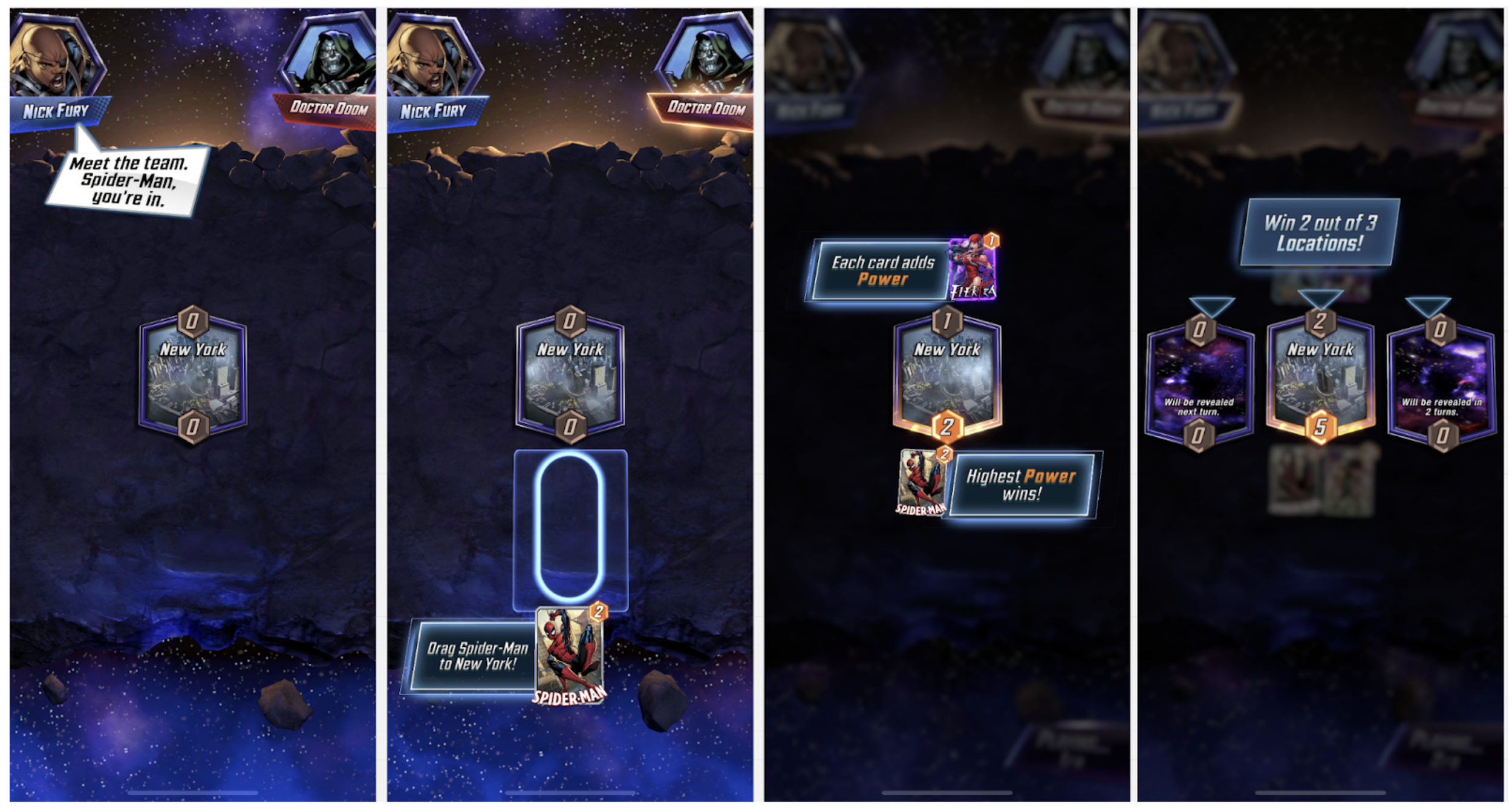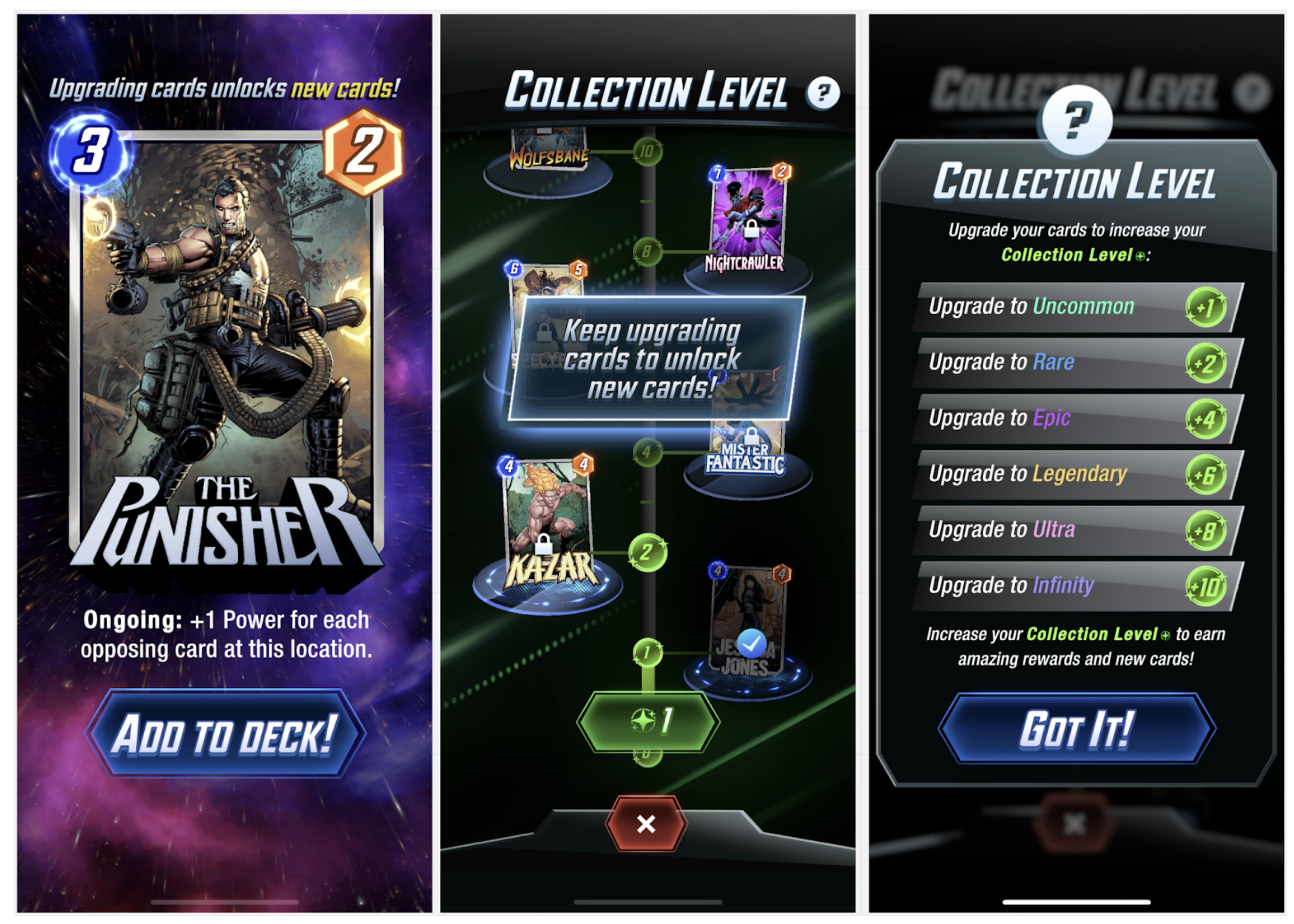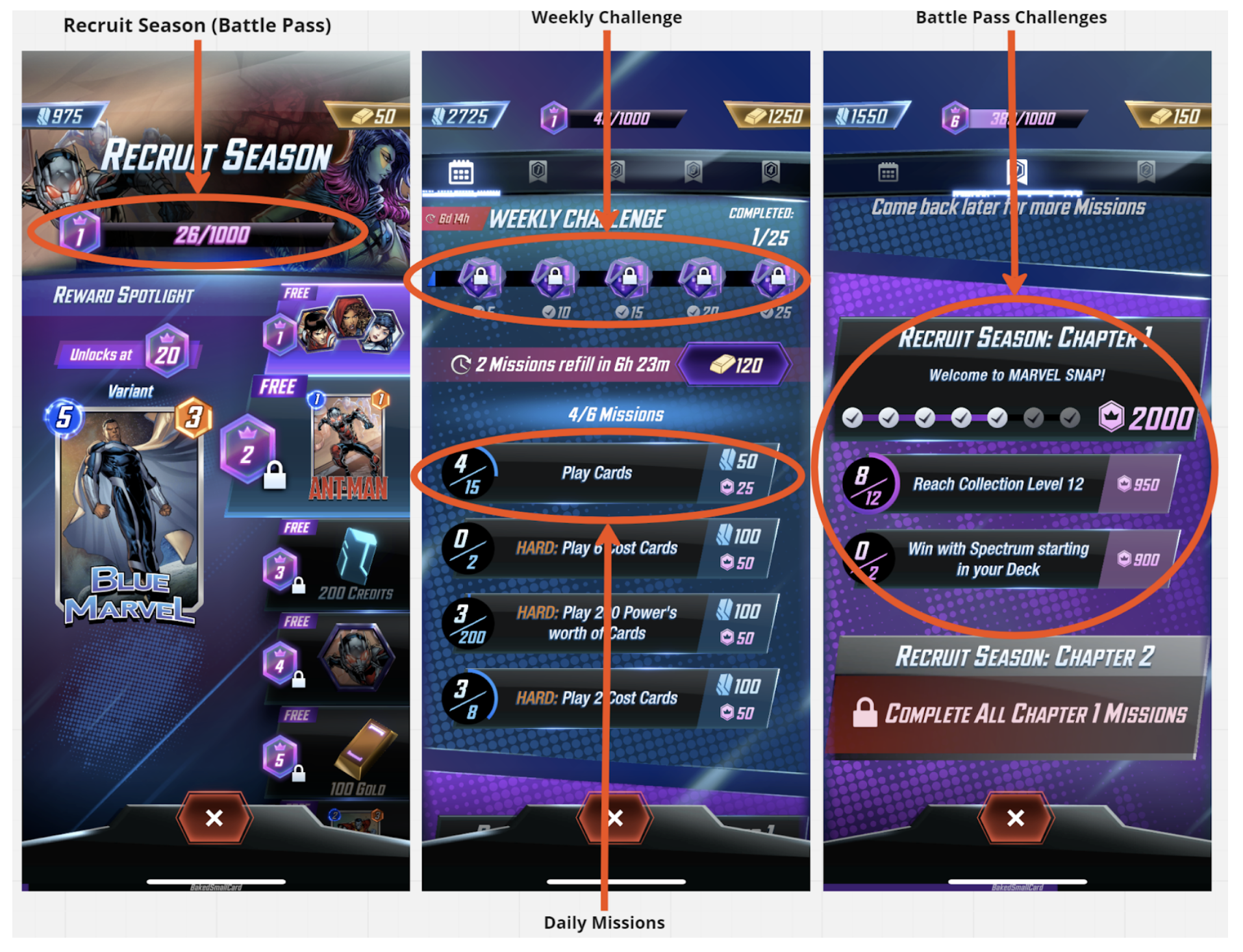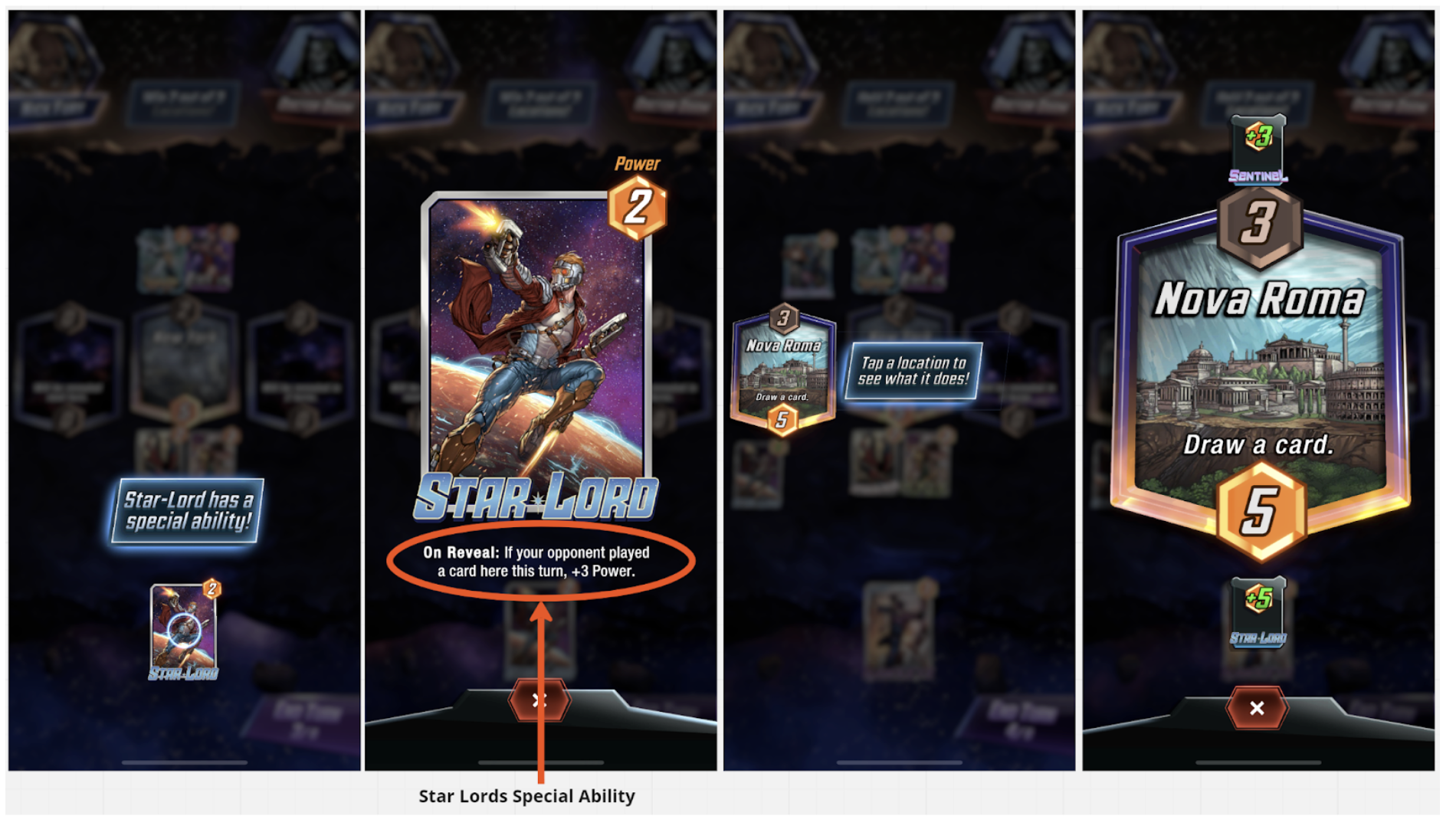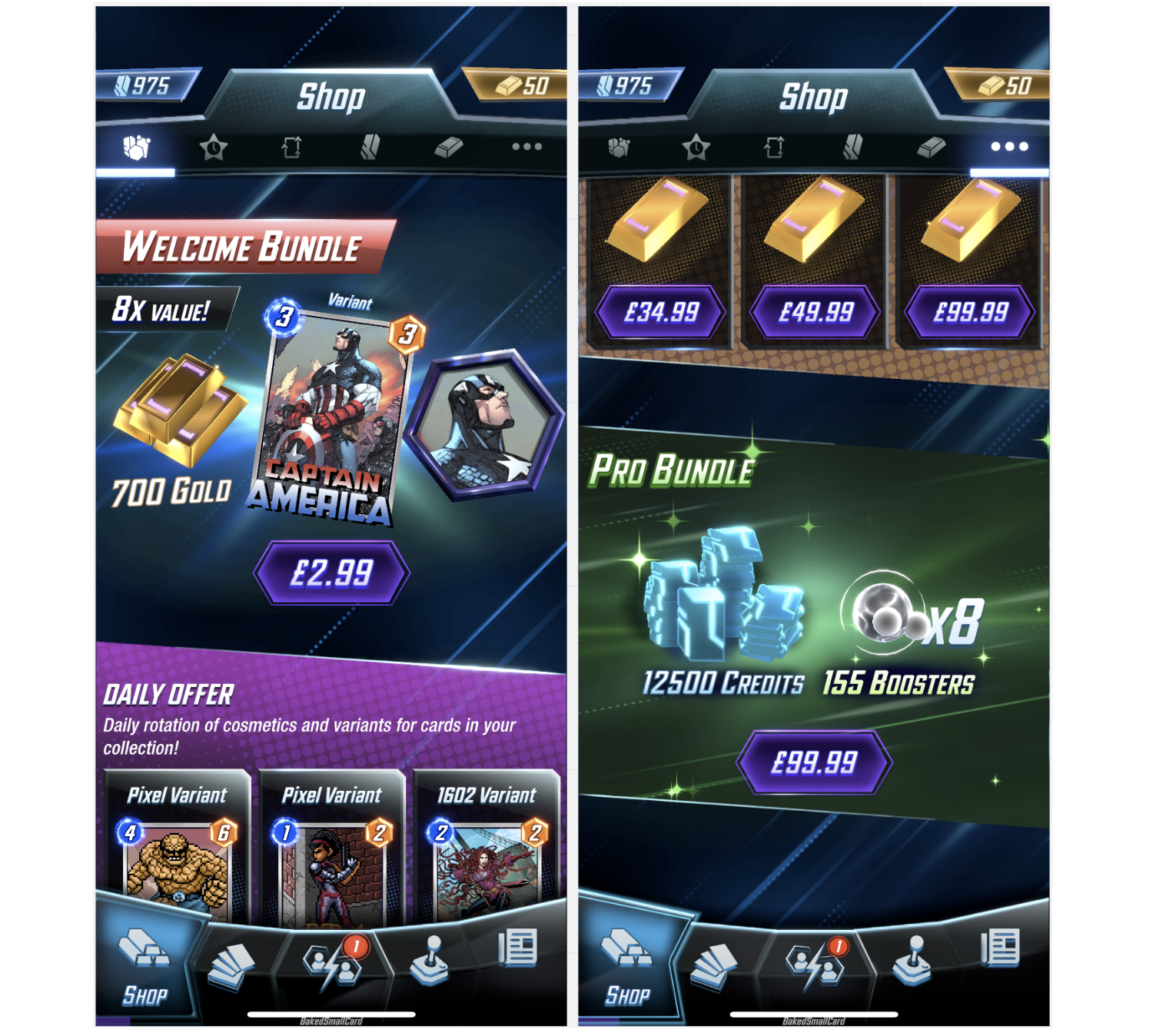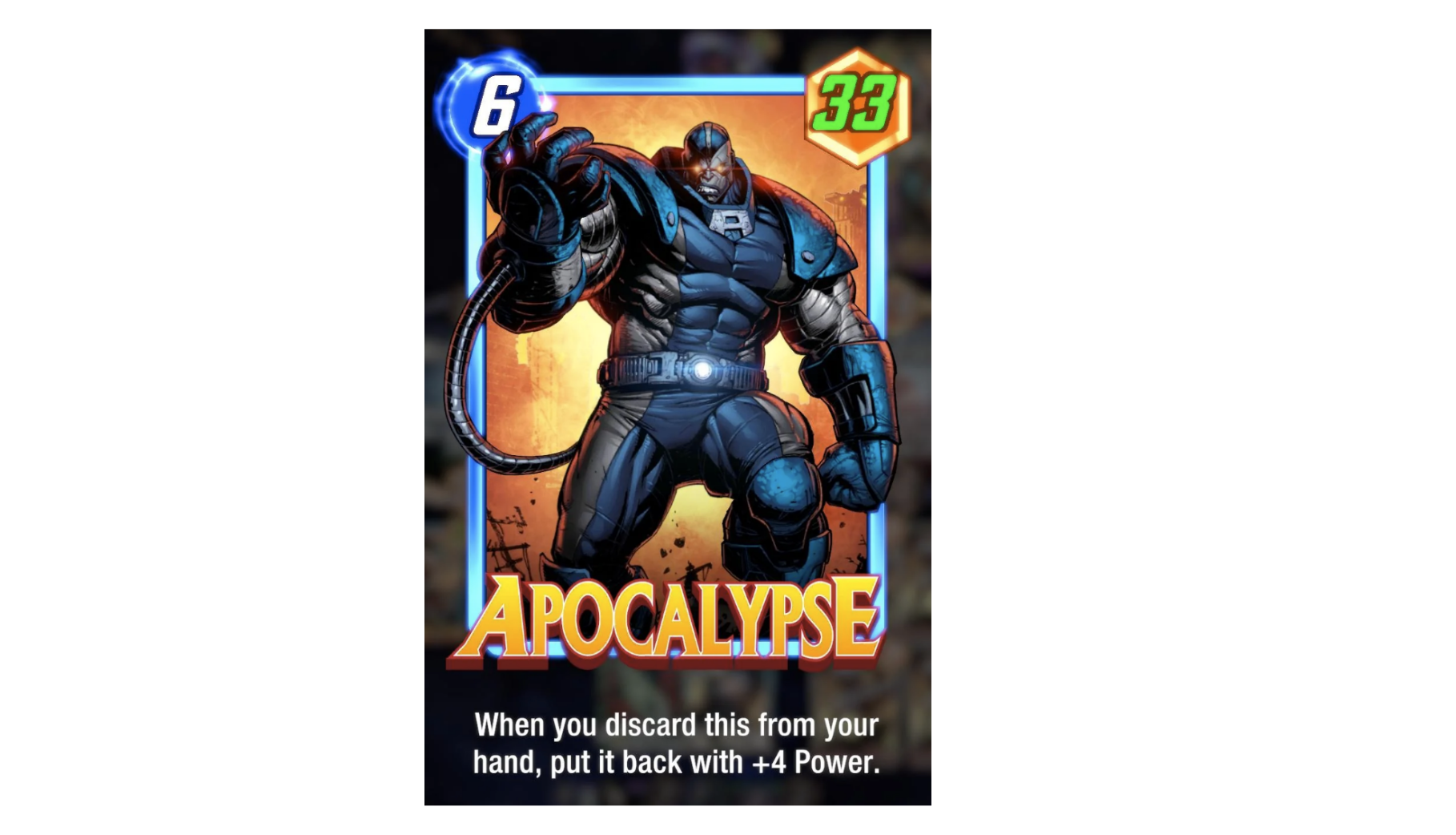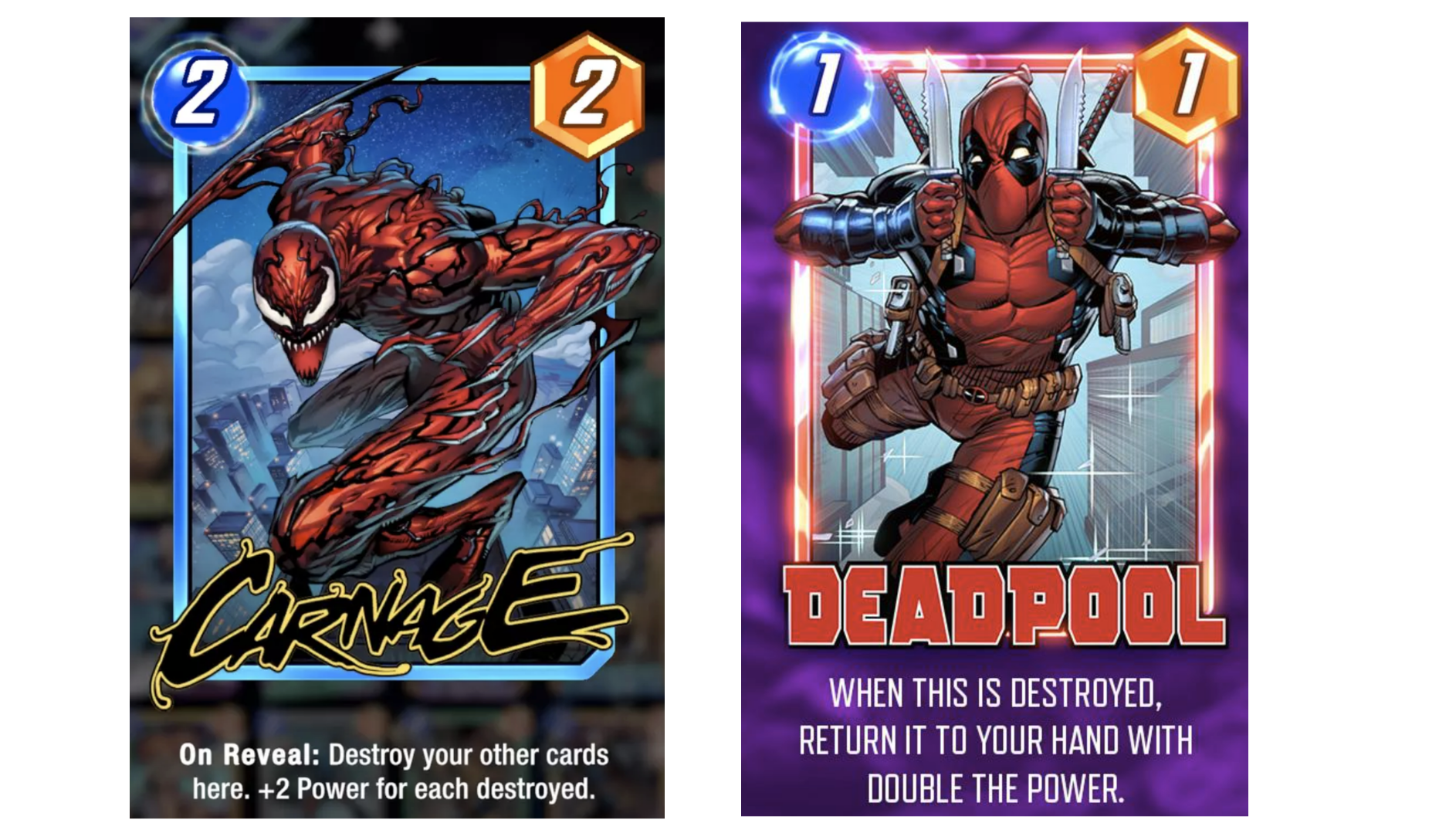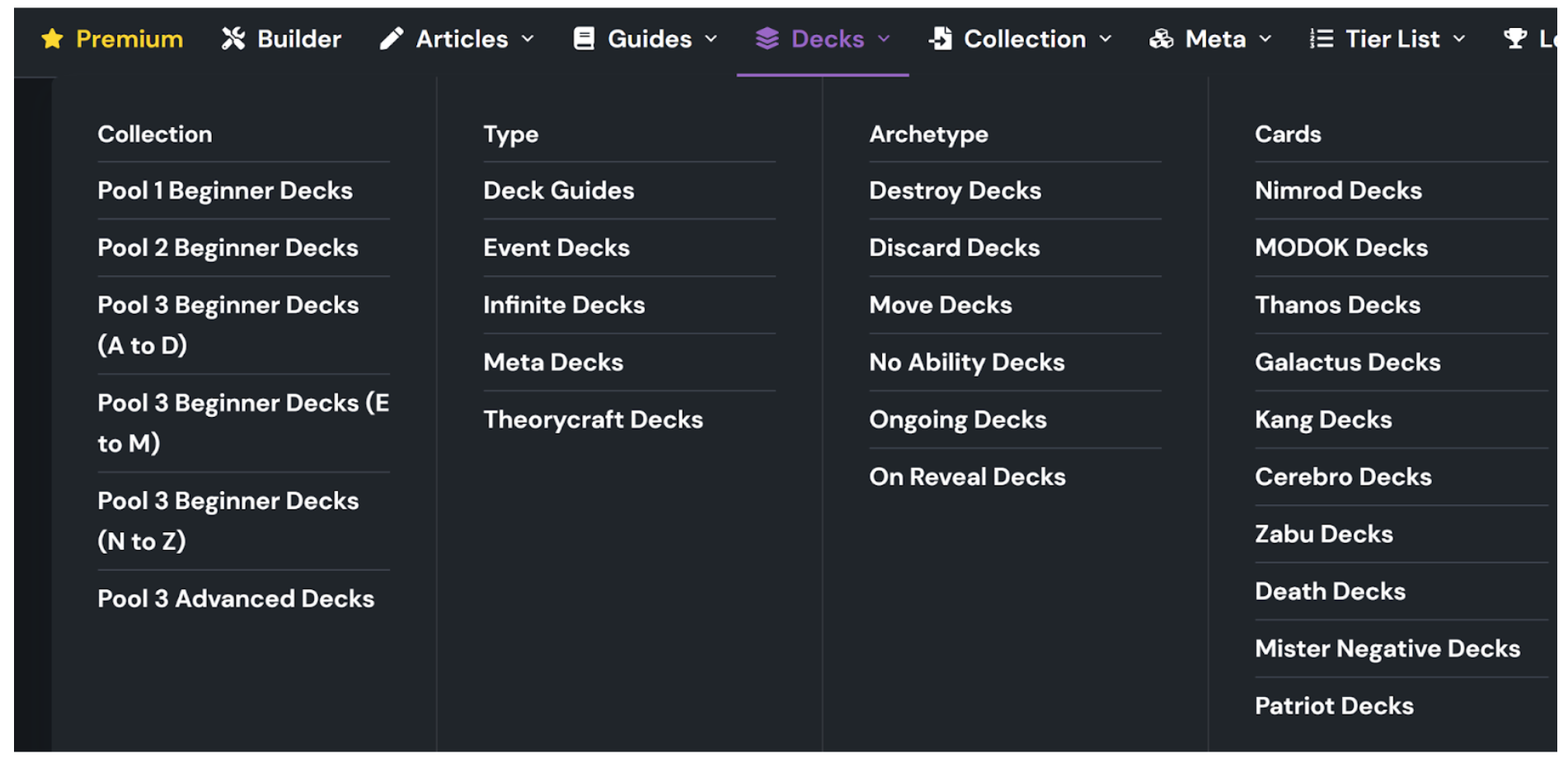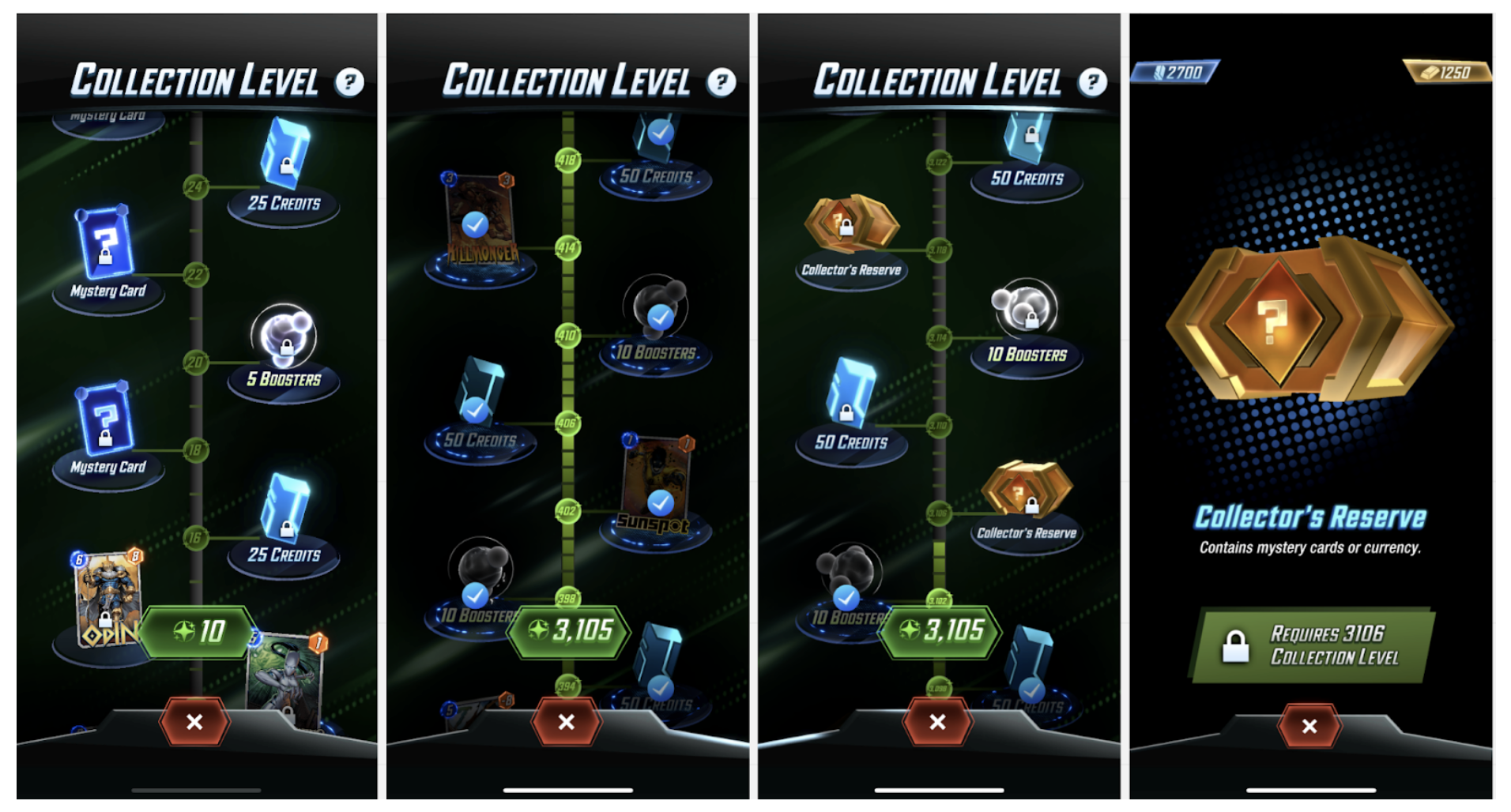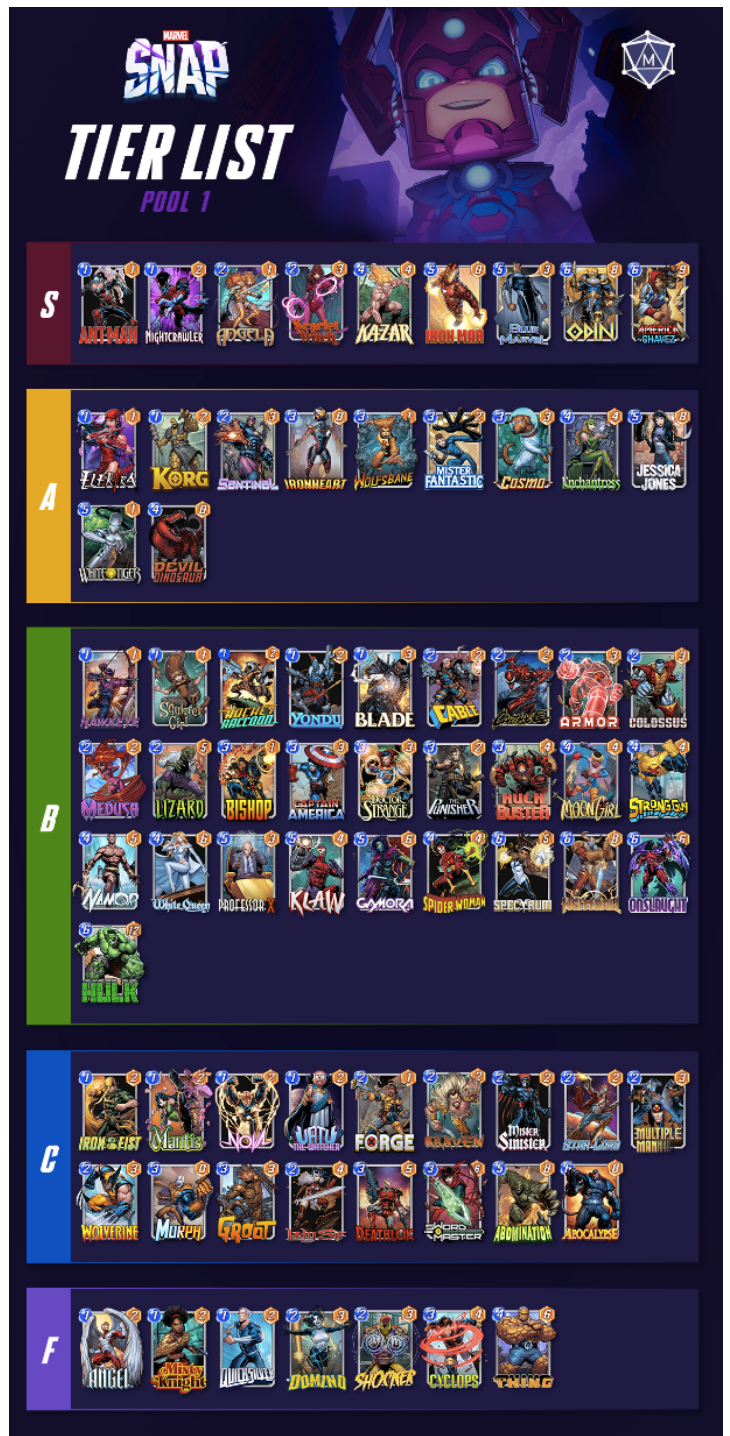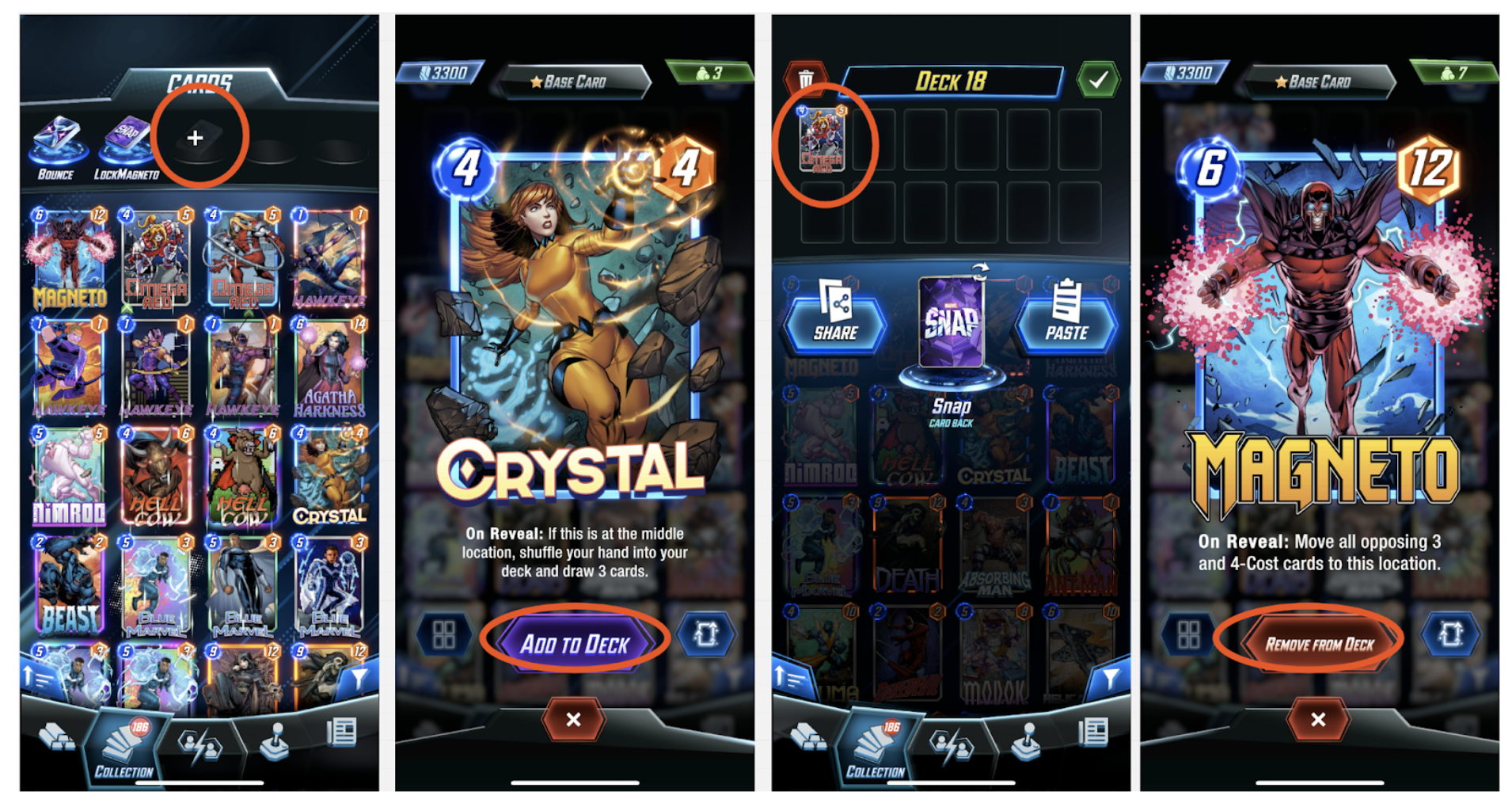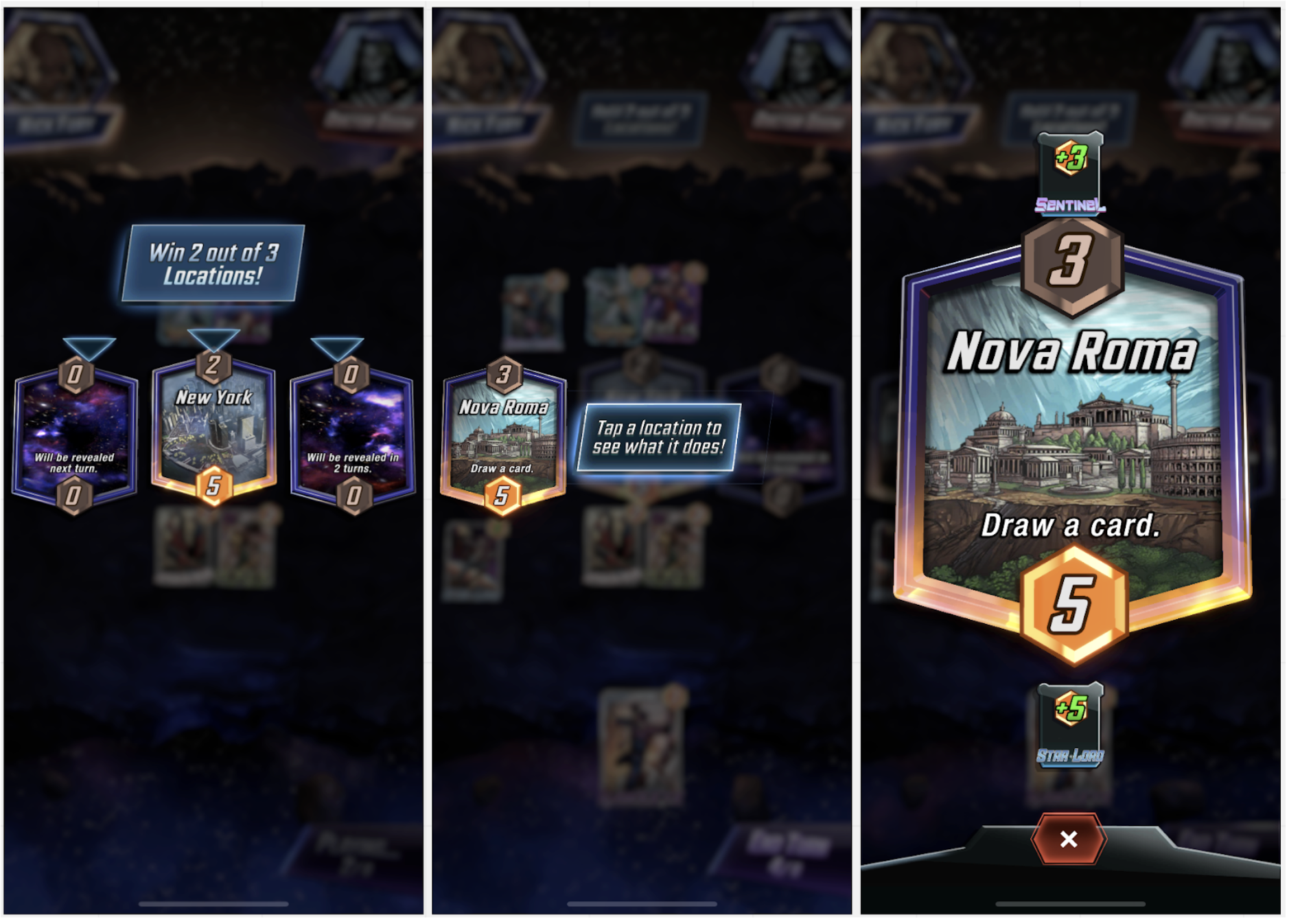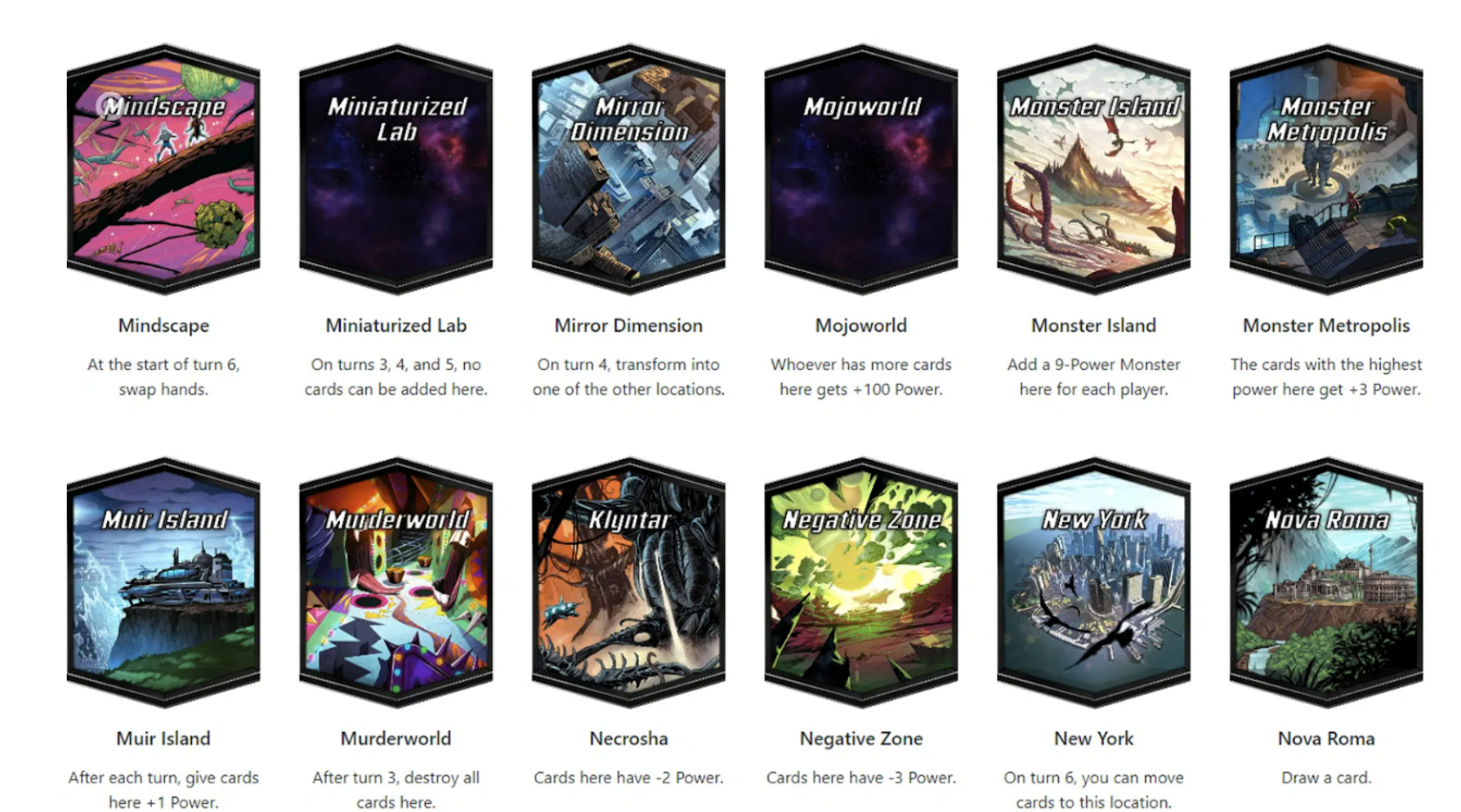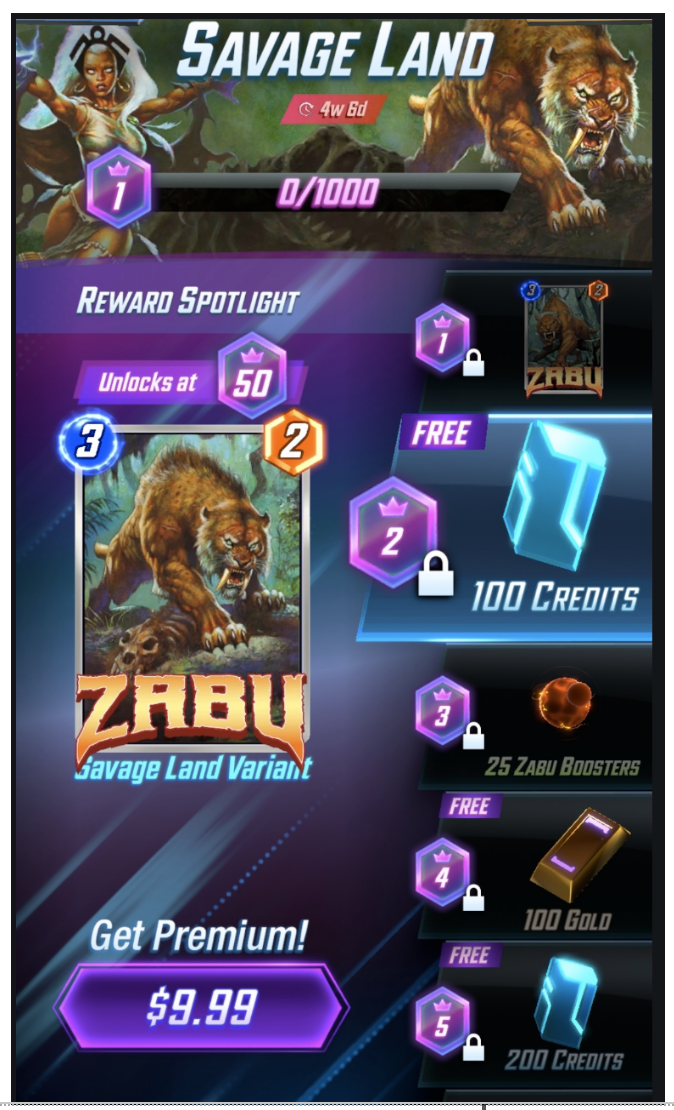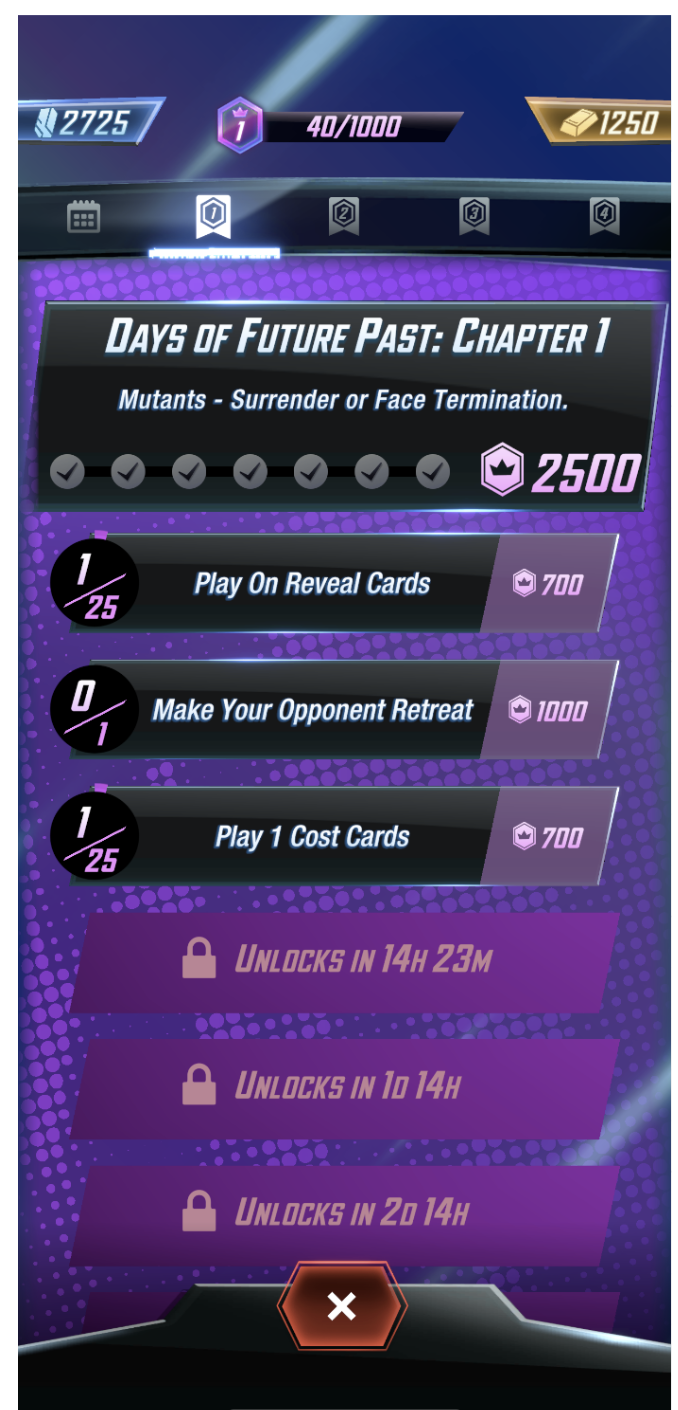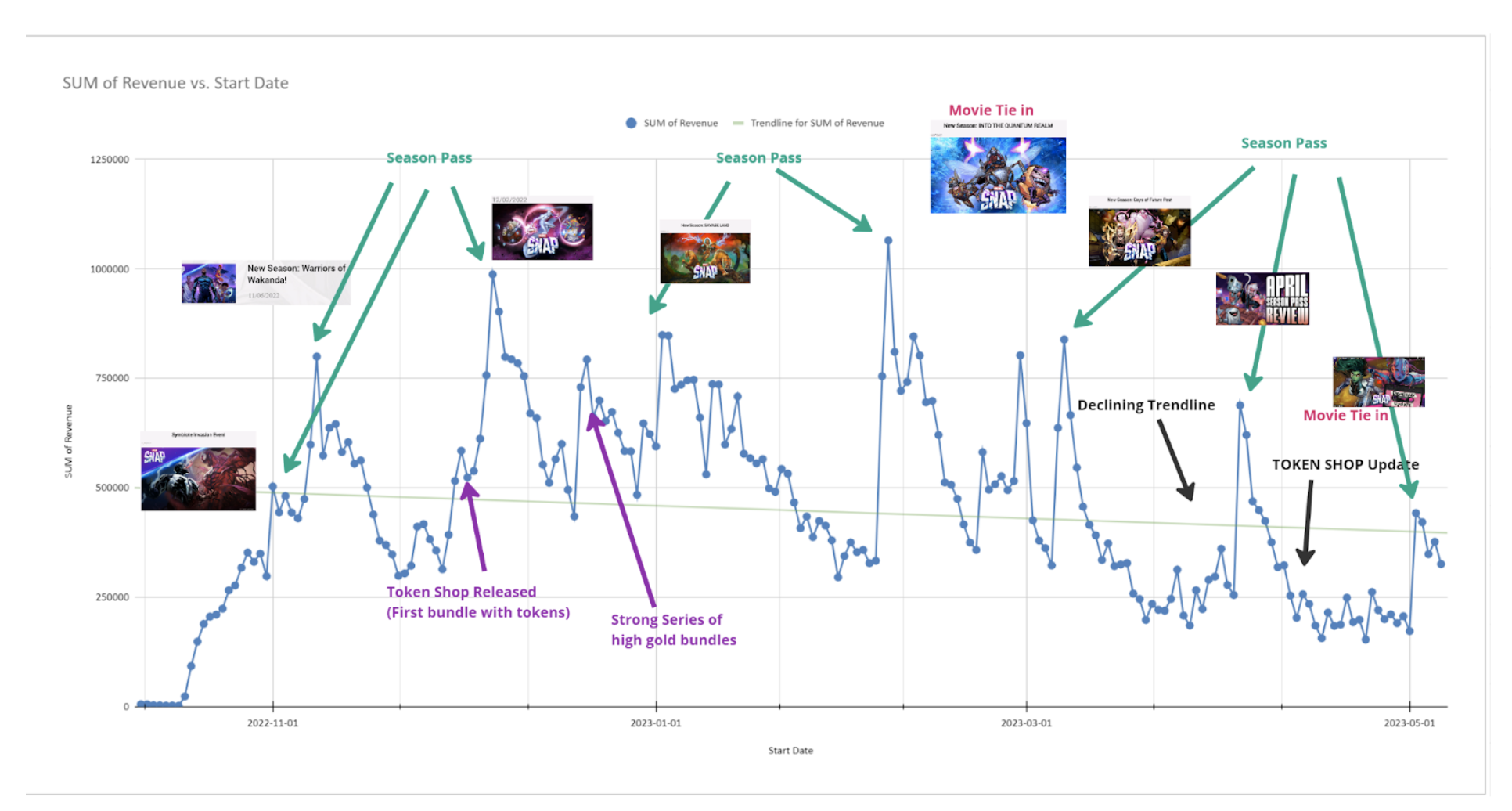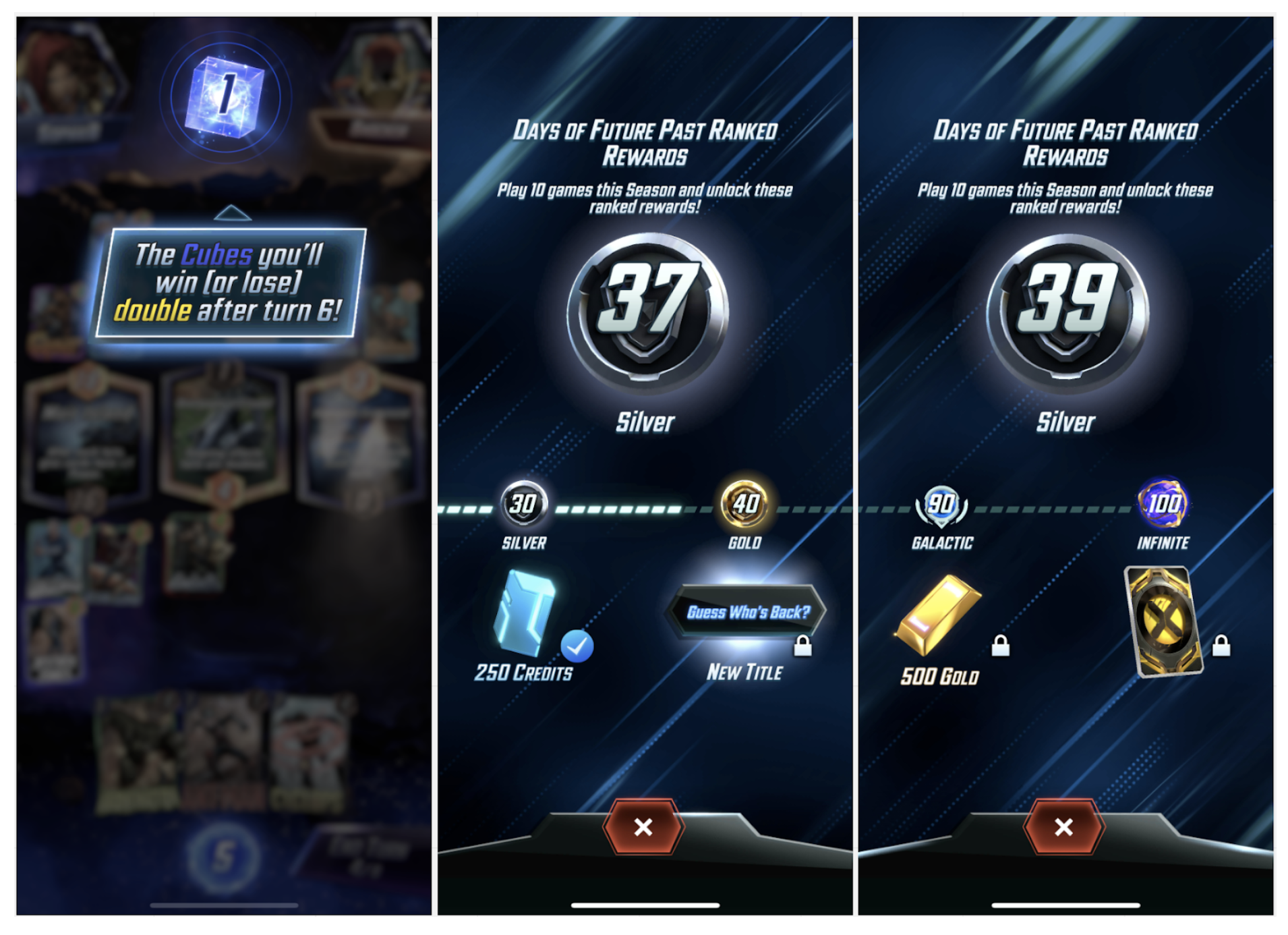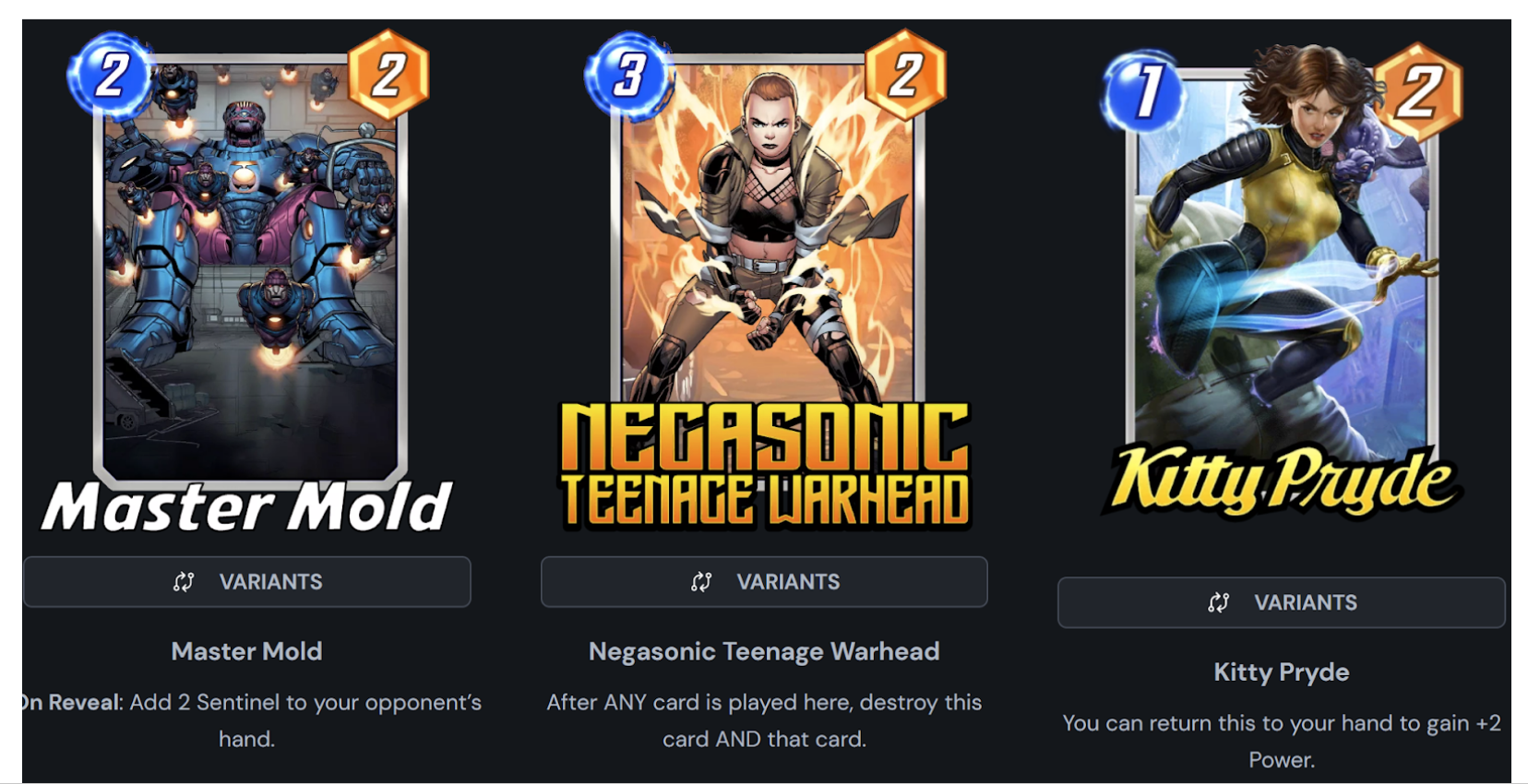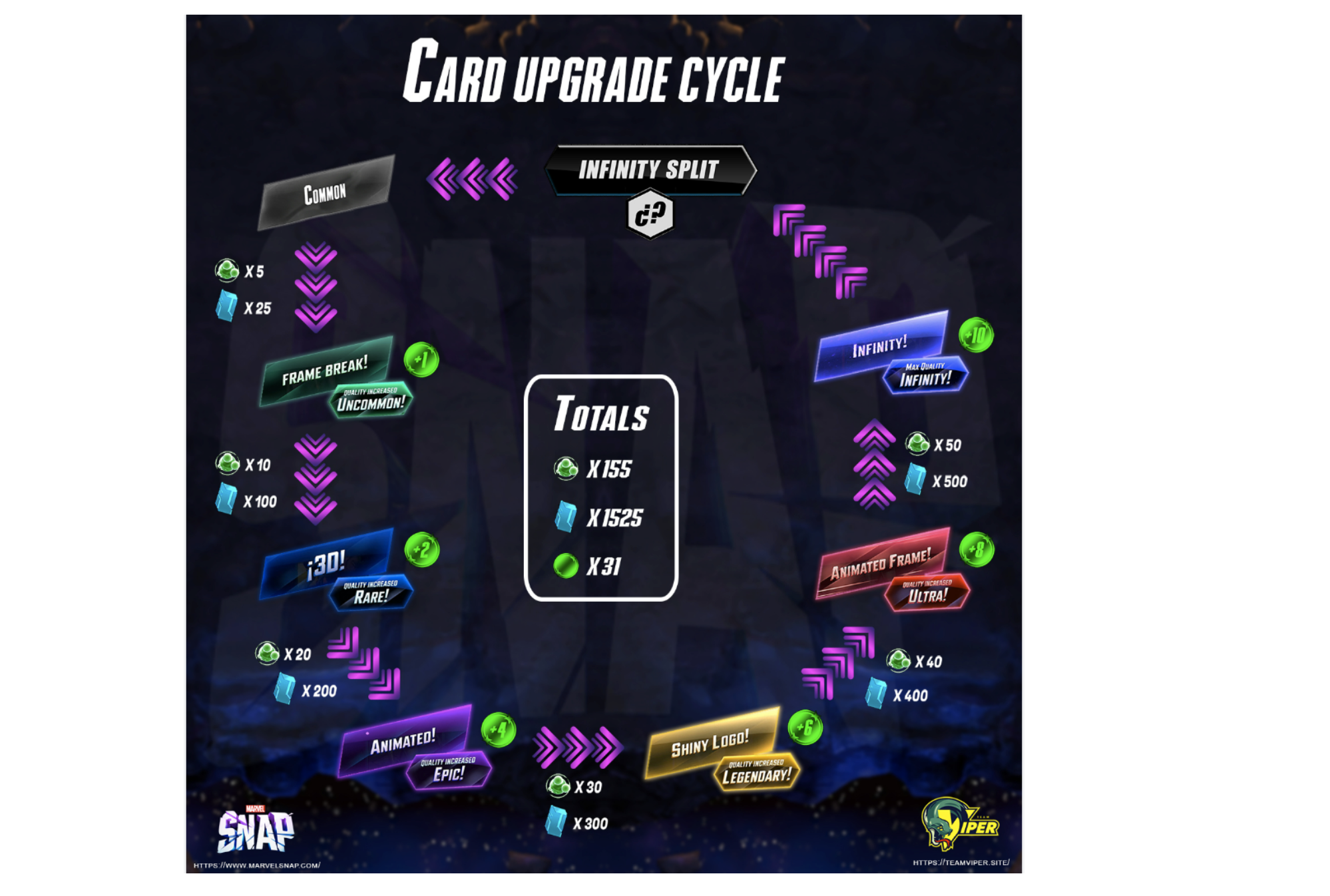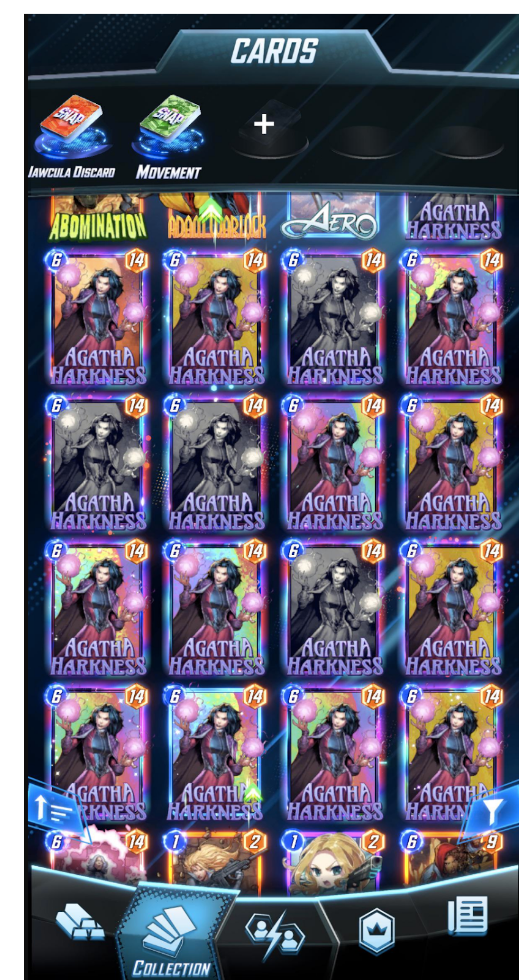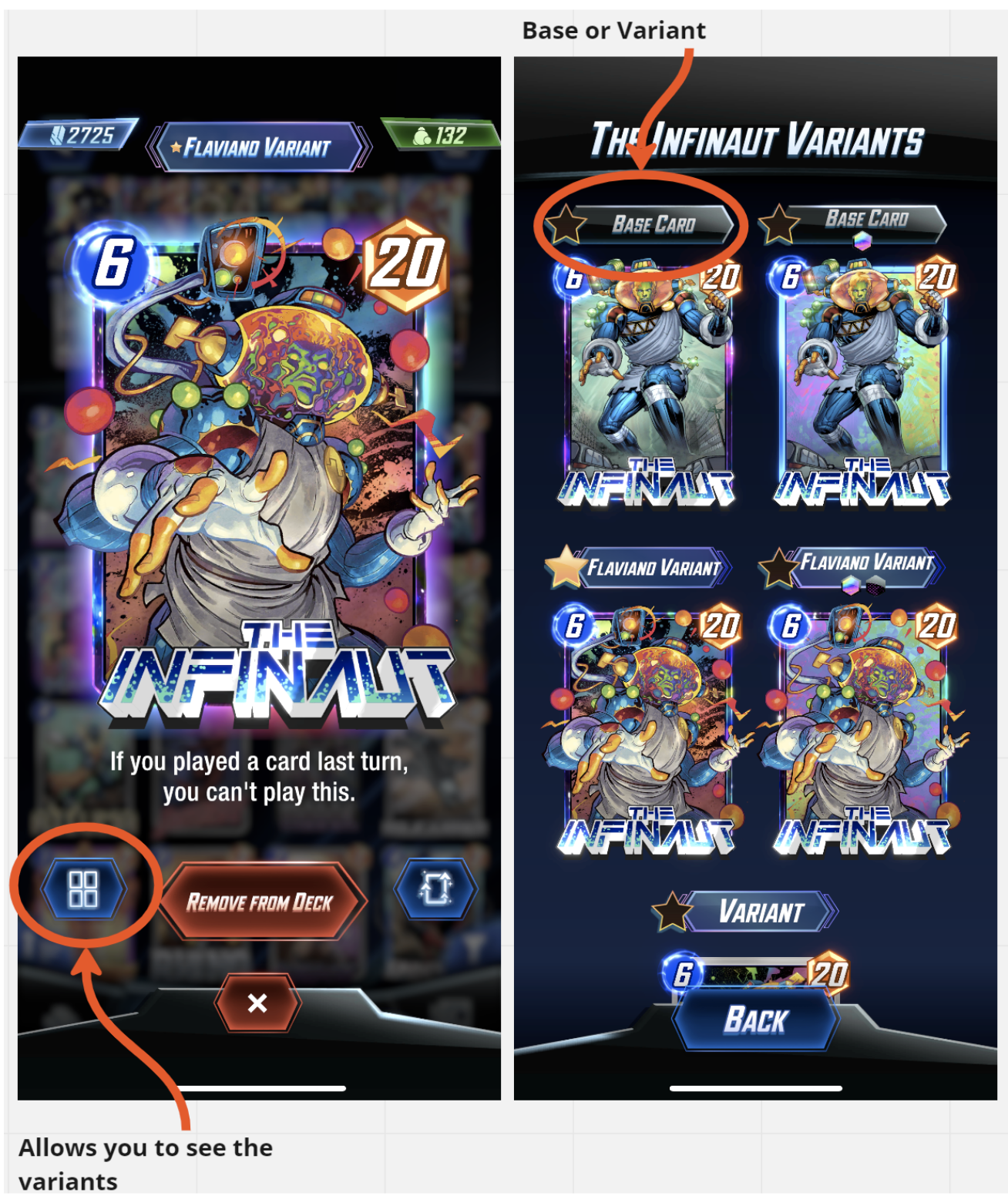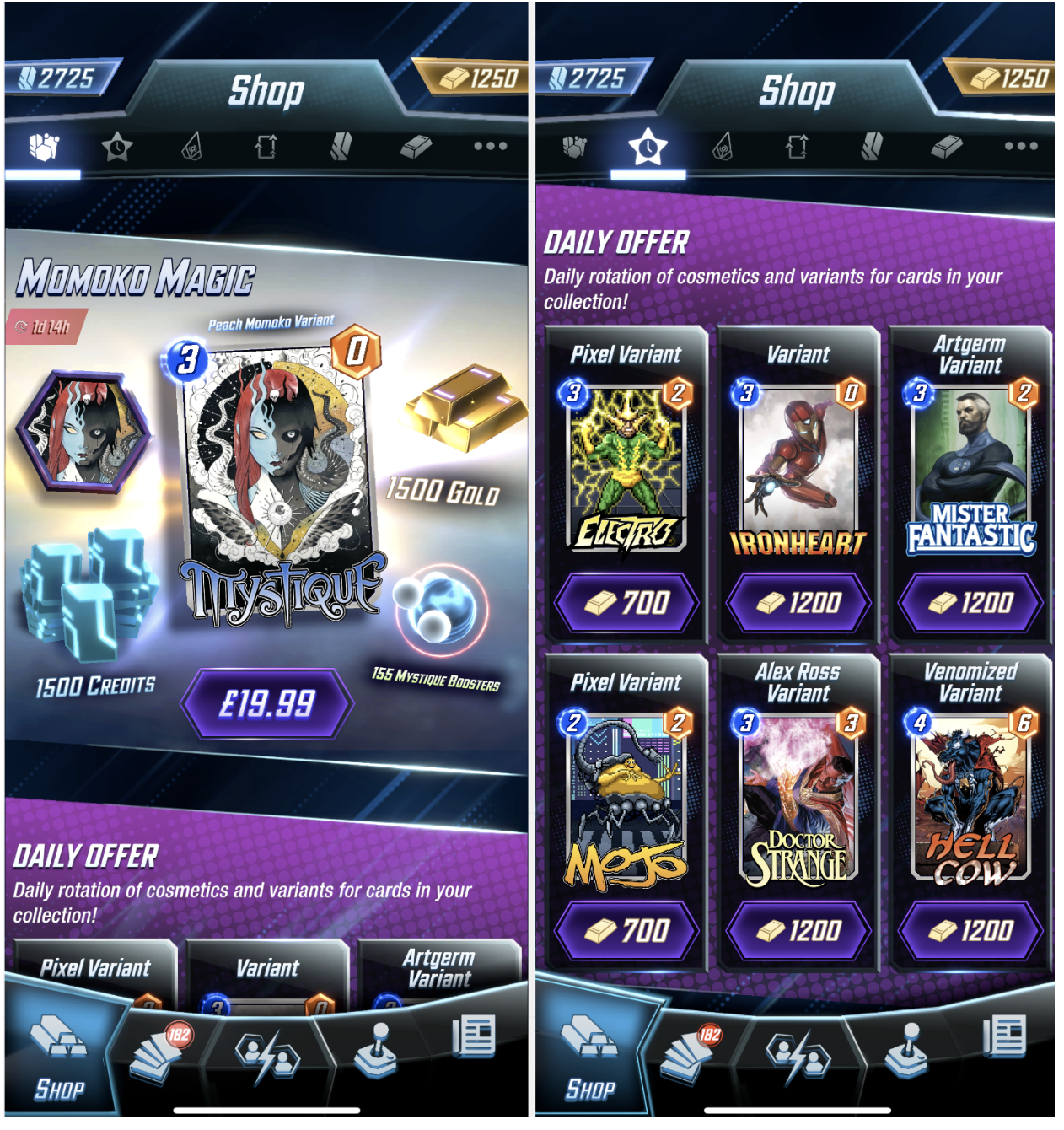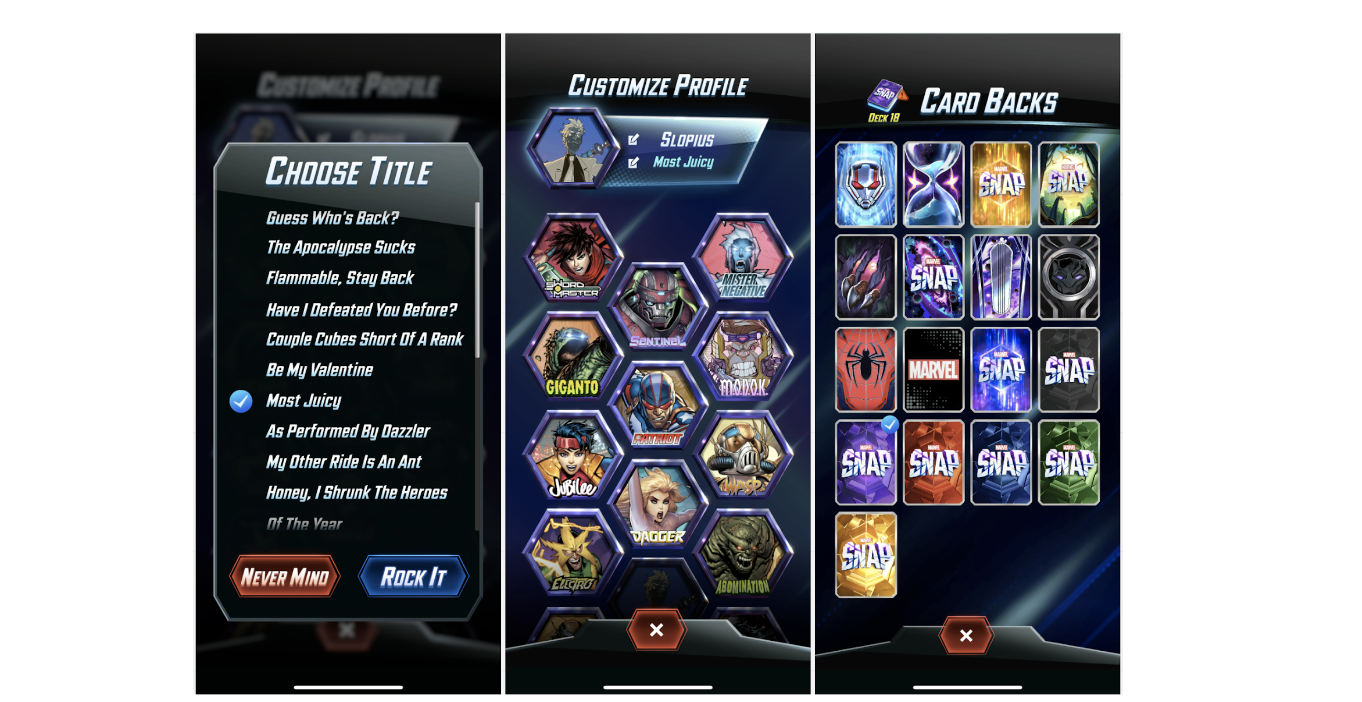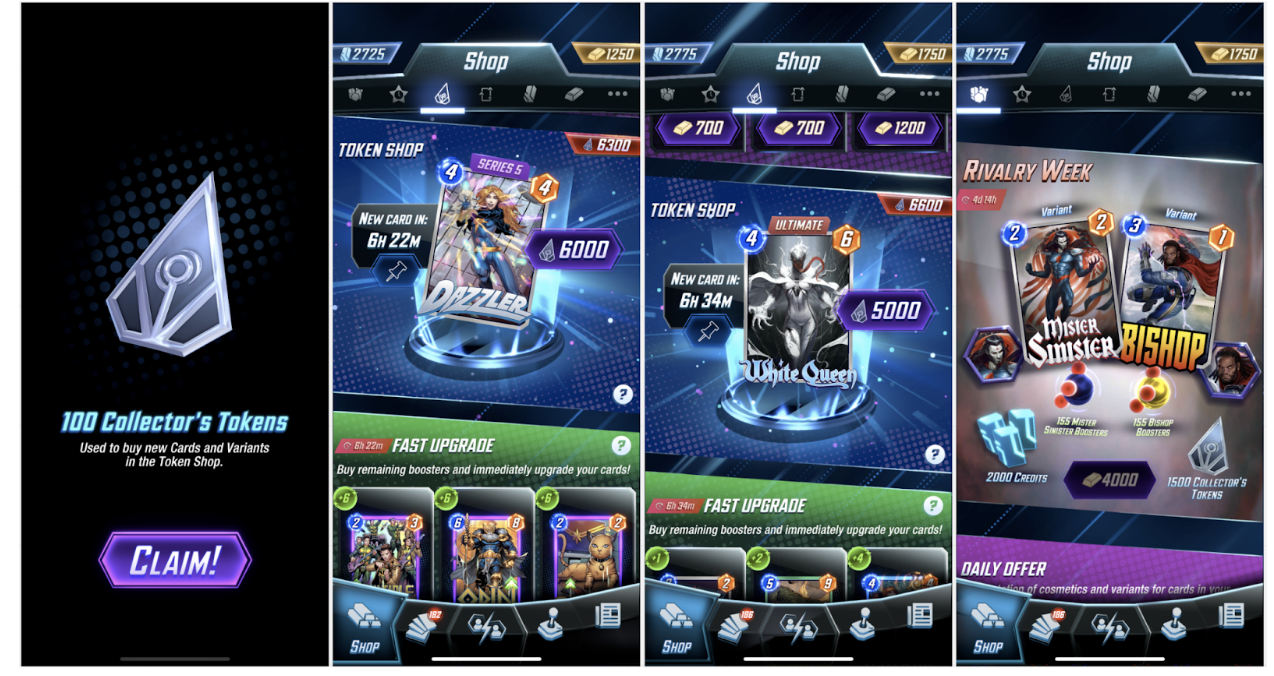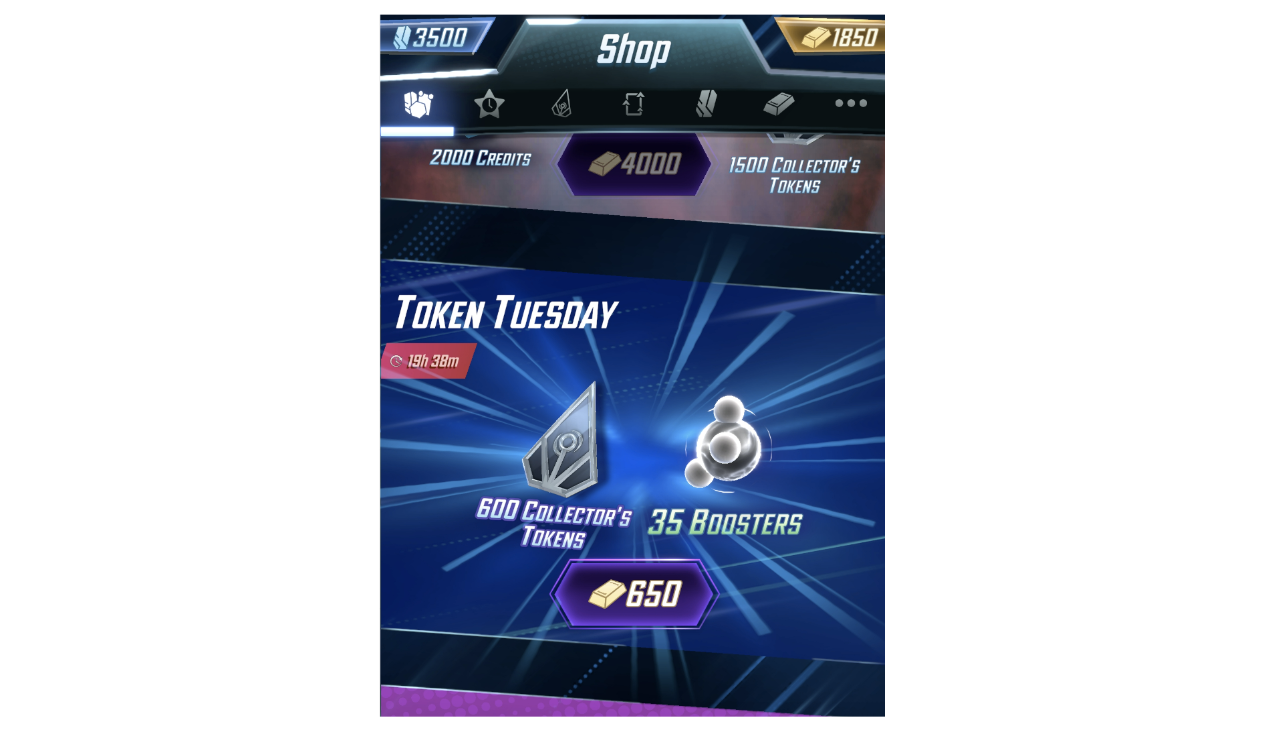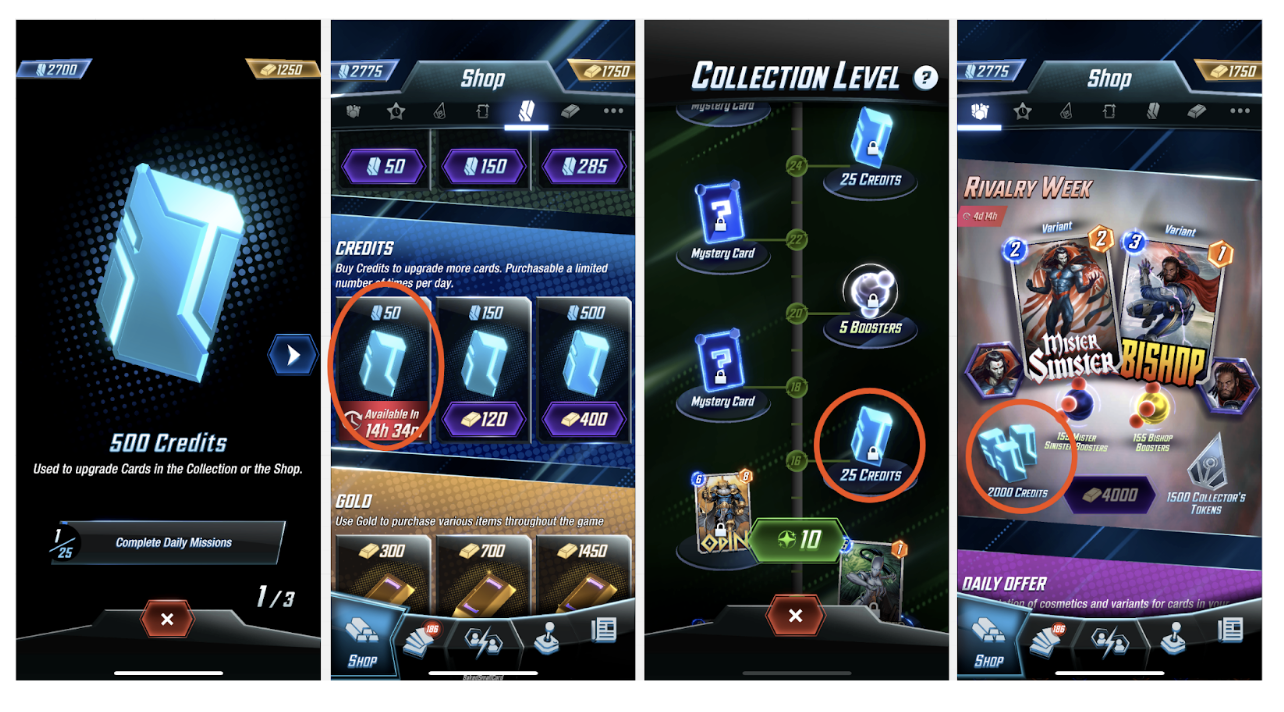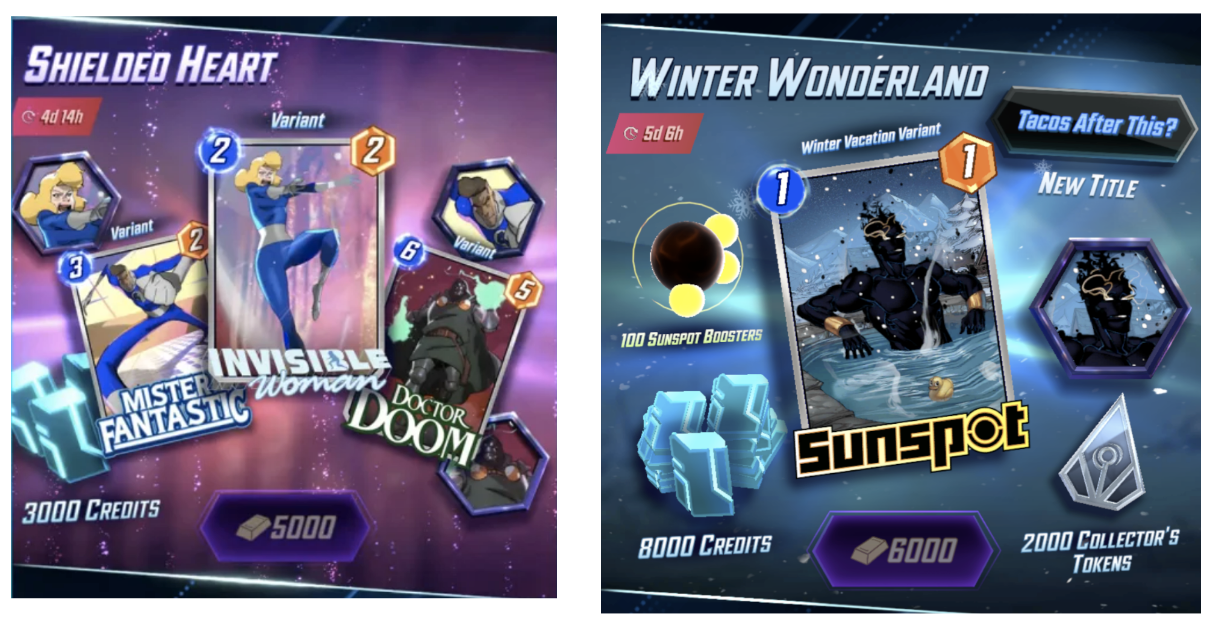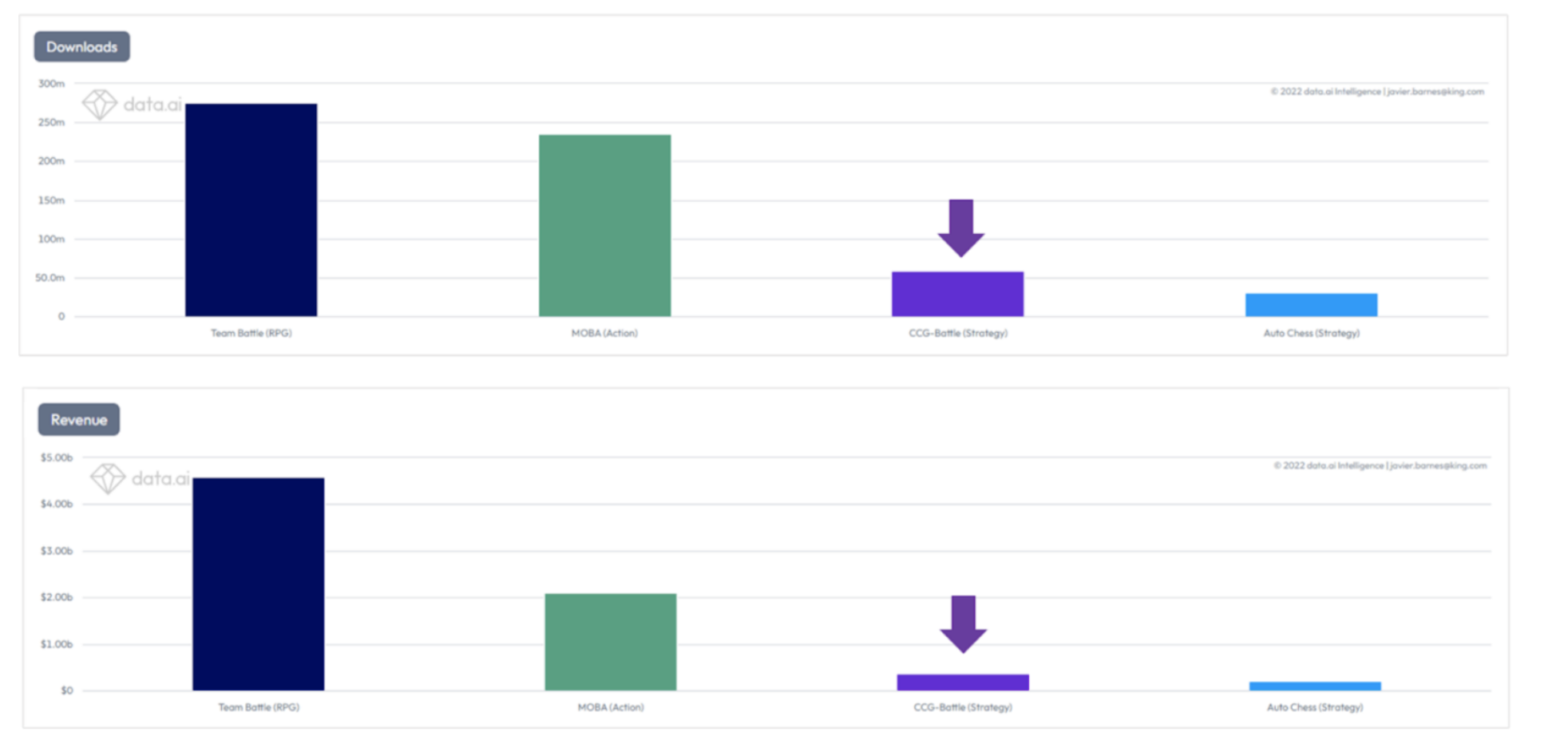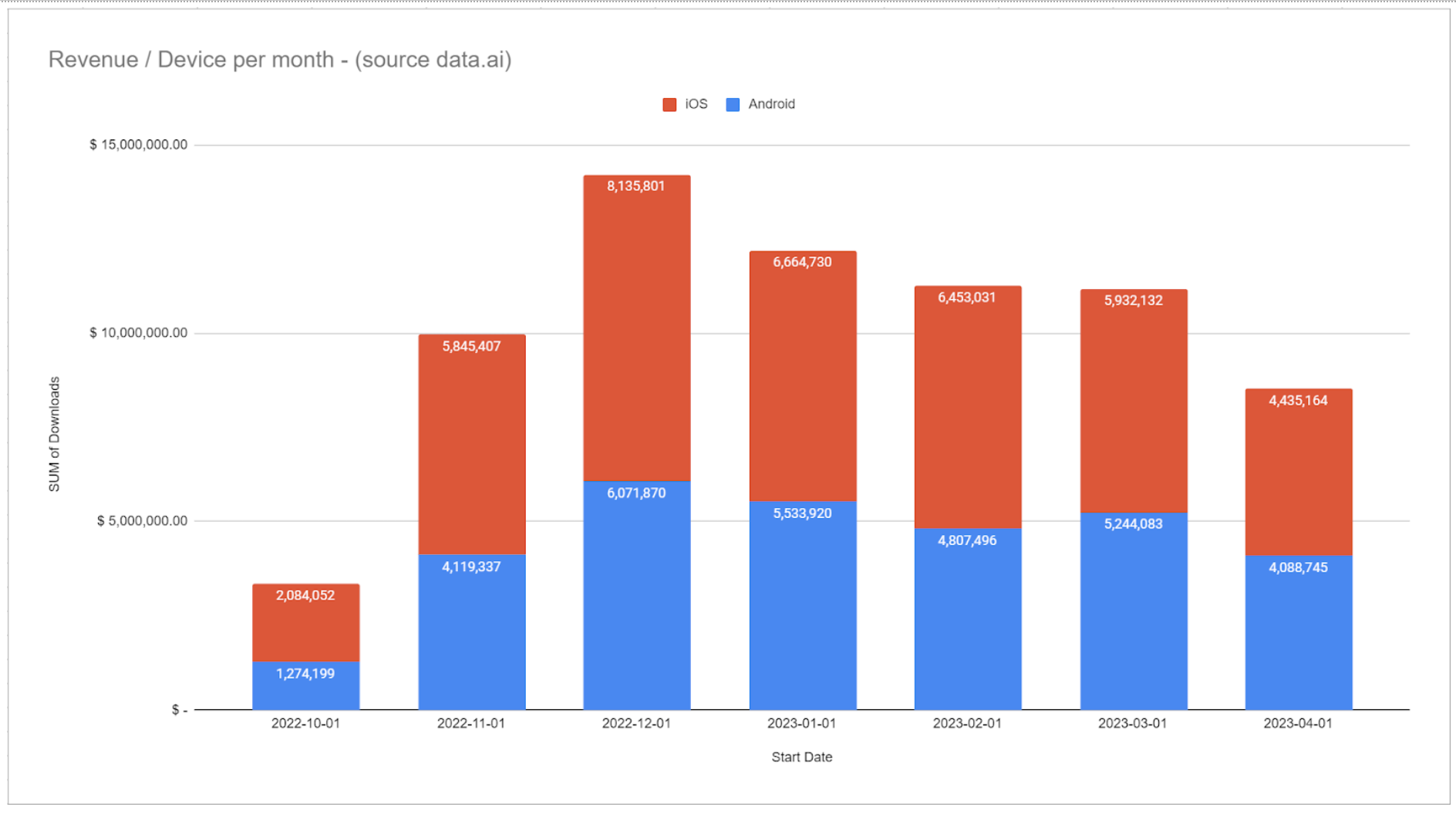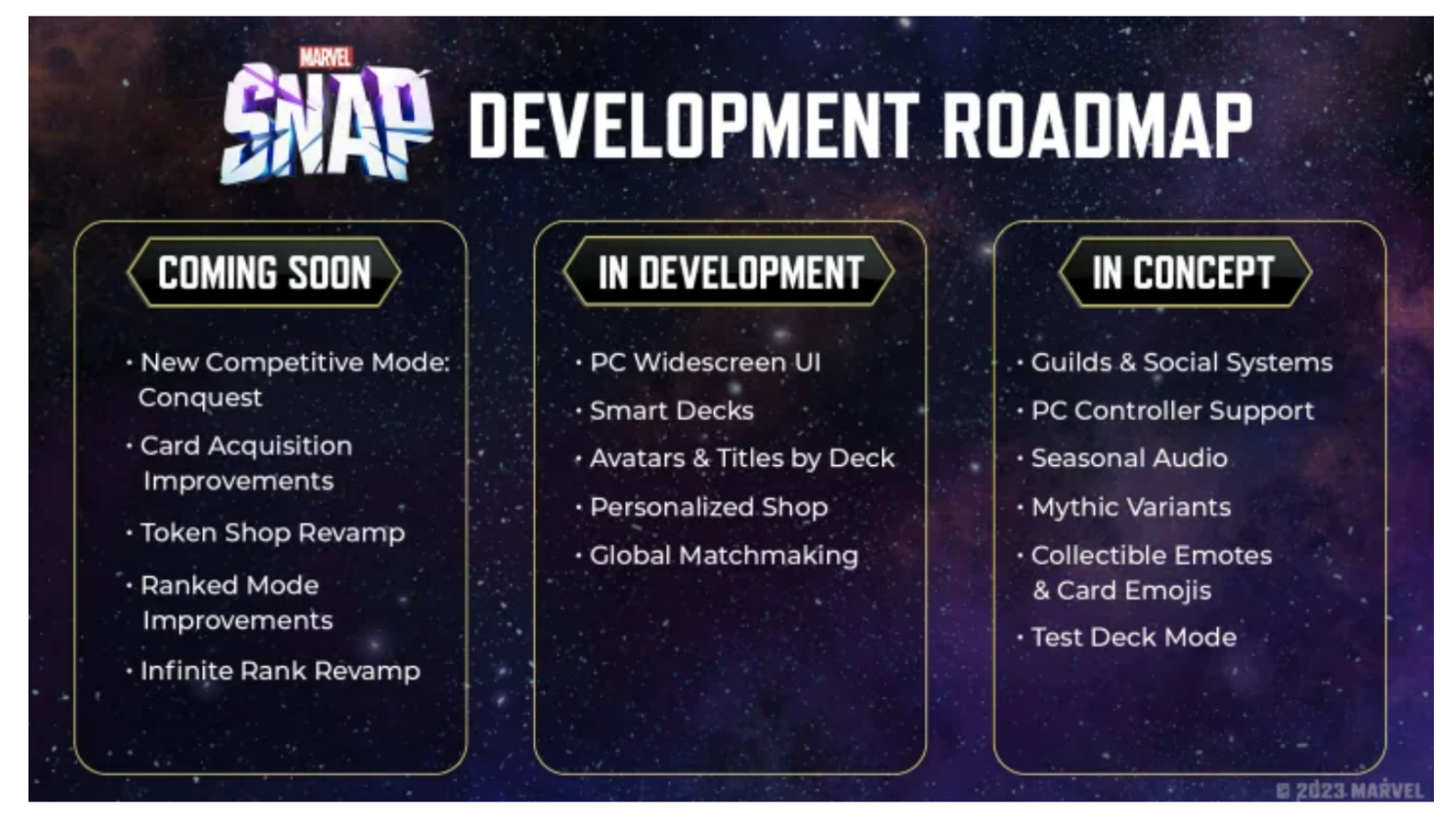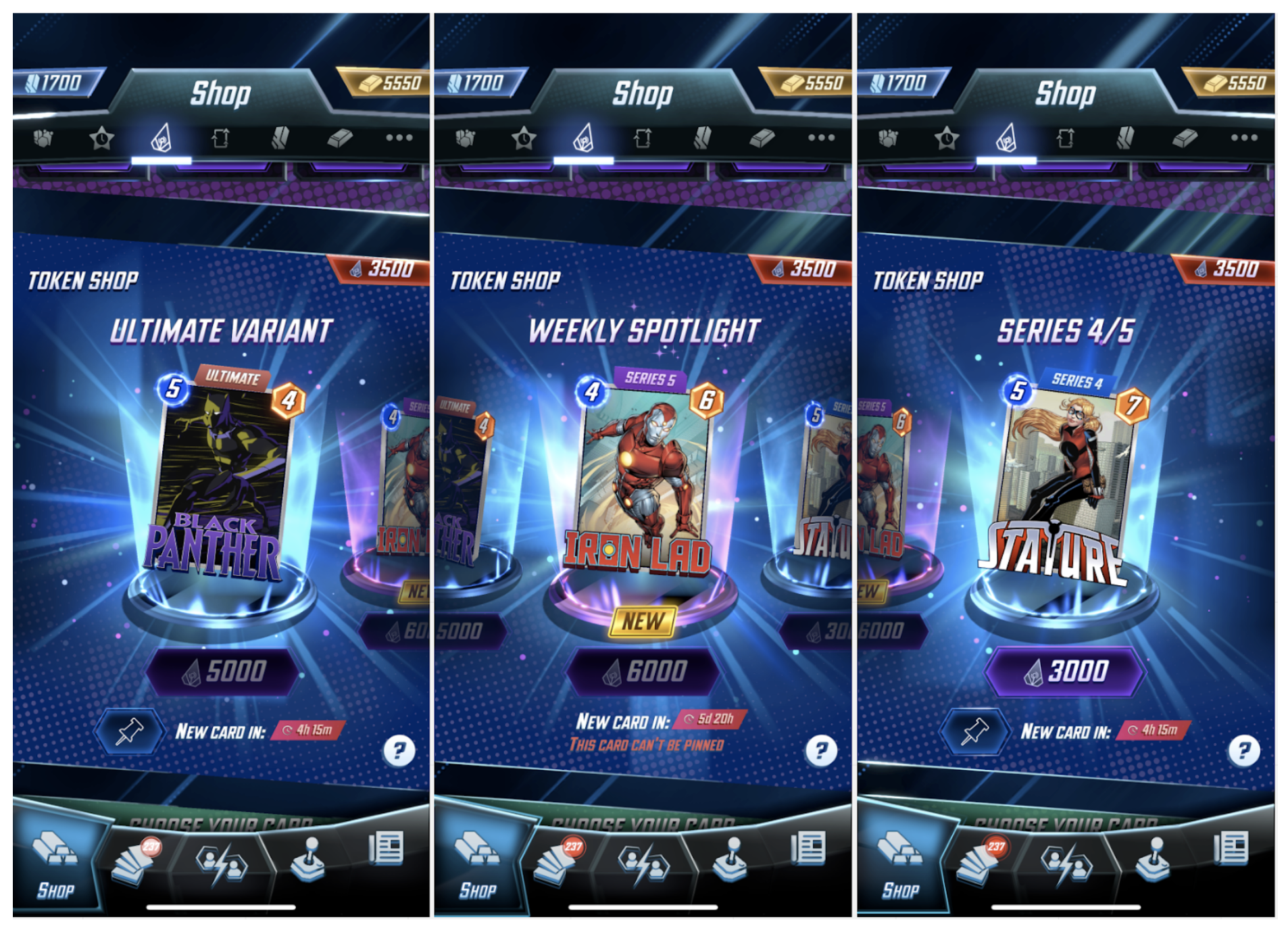Marvel Snap - The Definitive Deconstruction
In January on 2019, Hearthstone and Blizzard veterans Ben Brode and Hamilton Chu announced that Net Ease had invested whopping $30M into their newly founded studio.
The funding was deemed just enough for the team to reach the end of its first project without having to "scramble" for more funds partway through.
At that point, Second Dinner revealed that their first project just so happens to be a licensed Marvel IP, which the team has been working on for six months already and is currently beginning to playtest.
Fastforward to September of 2022 and the game, Marvel Snap, is finally out globally after a considerable amount of time in soft launch. What’s the best way to describe Marvel Snap? Well, it’s like Heathstone, Clash Royale and Marvel had a baby together.
What I mean by that it is easy to pick up and play, which for a card game is no small feat. The game is polished, fun, and accessible, which is a testament to the amount of time and effort that was put into its four year development.
Most importantly, the game was and is performing! During last 7 months it has amassed 16 Million installs, which is expectable for a Marvel IP. But what’s most important is that the Second Dinner’s first title, launched after the infamous ATT apocalypse, has amassed over $70M in net revenue till date and is on it’s way to crack 100M before the year is over.
As I walk you through the deconstruct, if you find yourself wondering how a new team was able to create such a high-quality game, the answer is straightforward: time, talent, and money, but most importantly, a lot of time!
Another thing that some of you might be wondering is: Why hasn’t the studio been acquired already? After all, they showed their ability to hire the best, get the biggest IP and execute flawlessly.
The funding of $30 million likely puts the value of the studio to around $200M, which would be a lot to pay for a studio with one title. But many companies would actually spend that amount if Second Dinner had published the game themselves. Problem is, Marvel Snap is published by ByteDance aka. the TikTok company.
So how much does Marvel Snap actually make Second Dinner after the minimum guarantee, lincensing cut and publishers cut? Clearly not enough to justify the price tag that would only get the acquirer the super talented team without publishing expertise and with a very expensive IP saddled on top of their first title.
What is Marvel Snap?
For a quick and general introduction of the game, it’s a player vs player only CCG game, which limits your cards to only 10 per deck, each game is less than 4 minutes, and it uses a very simple poker-like betting mechanic to keep things interesting.
Before diving into a detailed analysis of Marvel Snap, it's worth taking a deep dive into the game's unique approach to the initial user experience. Marvel Snap provides players with a complete, tailored game experience for the first 1-4 days (about 4 hours of gameplay). This approach helps guide players through the simplicity of the game, but it most likely also hurts the game as a business. Many games rely on a wide funnel of players entering the game, then offering them value right away through starter packs or other cheap purchases to keep them playing for a month or longer all while increasing the amount a player can spend as they progress through the game. Very few games limit the spend a player can do for very long if at all. As you’ll see with this teardown though, Marvel Snap severely limits spend, especially at the beginning.
The Beginning
Let me walk you through the beginning of the game to illustrate just how well done it is, while also explaining the game’s simple mechanics. At a high level just know that you have 10 cards to a deck. You place cards in 1 of 3 locations, those locations will compare the total power of the cards placed on them to decide who wins that location. Winning 2 out of 3 locations wins you the game.
Marvel Snap starts with a simple intro sequence featuring Nick Fury and Doctor Doom battling each other with you controlling Nick Fury. The game initially presents only one location (New York), and allows players to jump right into a battle without explaining moves or costs, or any of the complexities of the game; it saves that for later battles. This highlights the polished and impressive effects of the game. As players progress, the game gradually introduces the other two locations and clearly explains the objective of winning two out of three locations to win the match. They start you off with Spider-Man and leave out any abilities at first allowing for a smooth and enjoyable gameplay experience.
This intro makes it easy for players to get started and feel comfortable with the game mechanics. It's a great way to ease into the gameplay and get a sense of how battles work without feeling overwhelmed.
Once you have won, you are thrust into another battle and the game introduces you to the energy system, which is similar to other popular CCG games such as Hearthstone or Magic: The Gathering. However, Marvel Snap has simplified this mechanic to make it even more accessible. Each card costs a certain amount of energy to play, and you gain +1 energy per turn. This allows the gameplay to escalate over the course of the 6 turns, with some cards or locations providing extra energy. Overall, the energy system is straightforward and easy to understand, making it simple for players to jump right in and start playing
Now things get interesting. After being awarded a card, Marvel Snap introduces you to the game's meta-progression system. To unlock new cards, you must upgrade your existing cards, which is a unique feature in the game. However, what surprised me is that the upgrade only provides a visual change and no actual in-game benefits. Upgrading cards requires two resources: Credits, which are common to all cards, and Boosters, which are specific to each card. For instance, to upgrade the Psylock card, you must obtain a Psylock Booster.
Upgrading your cards is the key to progressing your player account and unlocking new cards in Marvel Snap. While some players may not care about the visual upgrade, there's a significant benefit to upgrading: it increases your Collection Level. As your Collection Level goes up, you'll unlock new cards and rewards such as Gold, Variants, Credits, or Boosters. The simple loop is:
They do a great job at reinforcing the loop constantly during the tutorial.
Finally, after walking you through the simple loop, Marvel Snap opens up the Battle Pass which they call Season Pass, and in the beginning, they call it the Recruit Season. As well as the Daily/Weekly Missions.
Every player starts off with a Recruit Season (Battle Pass), where there is no paid track at all, and players complete specific missions to progress and gain points for Season XP. The pink icon represents Season XP, and by earning it, players progress through a track and unlock rewards like Cards, Boosters, Card Backs, Player Icons, Gold (the Premium Currency), Credits, Mystery Card Variants, Season Specific Variants, and titles (more on all of those currencies later). This is a big risk for the game because players must complete this Recruit Season before unlocking the current live Season Pass, which can be purchased. It's surprising that it takes 4+ hours of gameplay to finish the Recruit Season, and on average, players might only play for about an hour a day. So, it could take at least 4 days of playing before players are asked to spend money on the Season Pass.
Season Passes are a huge revenue boosting as well as retention increasing mechanic. Obviously, they sacrificed some revenue here in hopes of creating a great onboarding experience but I’m not sure that sacrifice is really worth it.
To progress your Season Pass, players must complete daily missions to earn a small amount of Season XP, or complete the Season-Specific missions which often take more time to complete but reward a larger amount of Season XP. The way a Season works is similar to most Battle Passes out there, where missions are unlocked over the course of several weeks. By completing a bundle of missions, players can earn a large amount of Season XP. For example, by completing all 7 missions (see third screenshot above, 5 of which are already completed, with only 2 remaining), the player will receive 2000 Season XP. This is a huge amount, it will grant you 2 levels of Season Pass rewards!
The Daily missions in Marvel Snap are a simple and well-known mechanic used in many games. Every X amount of hours, players receive two new missions, up to a maximum of six. Each mission rewards players with Credits and a small amount of Season XP. The missions also progress a track at the top, which is the Weekly Challenge. The weekly challenge has milestones at 5/10/15/20 and 25 missions completed. When players hit these milestones, they are rewarded with Credits, Gold, and Season Pass XP. The rewards increase in amount with each milestone.
As you continue to engage in battles and progress through the game, Marvel Snap gradually introduces you to some of the nuances of the gameplay. For instance, players are introduced to the special abilities that cards possess, as well as the unique abilities of different locations. During gameplay, locations, where you place your cards, are revealed in order from left to right for the first three turns, and there are over 50 different locations to randomly choose from. Of course, for this curated experience they limit you to very specific locations. This element of unpredictability keeps the game exciting and challenging, forcing players to adjust their tactics on the fly.
Finally, Marvel Snap introduces the unique feature of 'Snap'. This feature is not introduced until players have played for a few hours, and from what I can tell, players are always playing against bots until they are introduced to this feature. This tailored experience helps players feel powerful and accomplished throughout the initial stages of gameplay. The two games where they introduce you to the Snap feature are planned and pre-determined by bots as well while making it seem random. It’s impressive.
‘Snap’ is a betting system where players can earn Cubes, which serve as their PVP rank within the Marvel Snap universe. The betting mechanic is similar to poker, and can be quite enjoyable.
The learning experience in Marvel Snap is carefully crafted to introduce players to the Snap feature. Initially, players are put in a winning situation and encouraged to Snap. Next, they are given an explanation of how the Snapping mechanic works. Essentially, if a player feels confident, they can Snap, which gives their opponent a chance to retreat, continue, or Snap in return.
Retreating means losing only the amount of Cubes the player is currently on. If they decide to press on, they will now be playing for double the amount of Cubes, with the stakes doubling again on turn 6. If the opponent snaps back, the game quickly intensifies, with the stakes skyrocketing from 1 Cube to 2 Cubes to 4 Cubes, and eventually 8 Cubes by turn 6.
The Snap feature adds an element of excitement and unpredictability to the game, allowing players to progress faster if they are confident, or bluff and scare their opponent into retreating. However, once a player snaps, they can't retreat until the following turn, so it's important to be confident in their decision.
Marvel Snap also teaches players how to retreat by having them purposely lose a game, without it feeling forced. This is quite clever and not easy to pull off. This is a nice touch, as it shows players the importance of strategy and risk management in the game.
We are almost done covering the beginning! Which once again I do believe is worth covering as this is the first time I’ve ever seen a game tailor the beginning so much, and to such an extent that I have a feeling many games will follow suit going forward.
Let’s talk about the store and the starter packs. What you can buy with what currency etc.
The store is one big long scrolling list, and it’s broken up into 6 main sections, but let’s focus on the main four first.
Daily Offers, here you will find 6 different card variants (I’ll cover variants more in depth later) for cards that you already have, and it costs Gold. Anywhere between 700 and 1200 Gold. So somewhere between $10-$20 USD per variant
Fast Upgrades, this is where you can buy the next level worth of Boosters for three specific cards, for credits
Credits, you can claim 50 free Credits a day here or buy more credits for Gold
Gold, you can pay real money for Gold
There are 2 other sections to the shop but I’ll talk about the Token Shop a bit later as you don’t unlock this until you finish the Recruit Season.
Let's discuss monetization, which I believe is an area where the game falls short and leaves a lot of potential revenue on the table. It was perhaps the biggest gamble the developers took with the game, and I'm not entirely sure if it has paid off for them.
Although the game is doing well for itself overall, I can't help but feel that it could be doing even better if the monetization system was stronger.
For example, before completing the Recruit Season Pass, which takes over four hours of actual gameplay to finish, players can only spend real money on two specific packs (apart from Gold, which only offers cosmetic variations and no real utility). These packs are the Welcome Bundle and the Pro Bundle.
The Welcome Bundle is a decent value pack that includes a Captain America variant, an avatar, and 700 Gold for $2.99. However, I had a disappointing experience with it. I thought I was purchasing an exclusive card, but later found out that it can also be earned through the Collection Levels path. As a result, I ended up feeling like I wasted my money. While the bundle is a good deal overall, it's important for the game to make it clear that the card can also be earned through gameplay to avoid any misunderstandings or dissatisfaction.
The Pro Bundle is an incredibly expensive pack that lacks clarity. At first glance, it doesn't seem worth the price as it only includes 12,500 Credits and 155 Boosters, which isn't a lot. The value proposition is not immediately apparent, and it's not intuitive to understand how buying this pack will allow you to level up your Collection Level to level 250 and unlock new cards.
The lack of transparency and steep price point make it a difficult sell for players. In fact, there are many articles online that discuss how the Pro Bundle is not worth it. The game could benefit from better communication around the benefits of the Pro Bundle, or even throw in a unique variant, or some Gold! Anything really. This is an easy fix for them, to address and would stop the many articles about how terrible the pack is (read: I purchased the pro bundle so you can all laugh).
As the Welcome Bundle and the Pro Bundle are the only options available for purchase during the first few days of gameplay, the game is leaving a significant amount of potential revenue on the table. It seems that the developers are banking on players playing the game for a long time and gradually spending money on it.
Personally, I was so hooked on the game that I was ready to spend $50 on it. However, I was disappointed to find out that I couldn't open a booster pack, and that I couldn't even purchase the Recruit Season Pass. This left me feeling frustrated, as I was eager to support the game and contribute to its success, but was unable to do so. The game could benefit from offering more options for players to spend money early on in the game, in order to capitalize on their engagement and willingness to invest in the experience.
Depth - Marvel Snap
While I've covered a lot about Marvel Snap so far, CCG games are known for their depth and complexity, and this game is no exception. It's packed with features and functionality that make it easy to engage with socially (outside of the game), including forums and the ability to share card ideas. These features allow players to change the card meta and contribute to the ongoing development of the game.
What's surprising is that the game is also accessible on PC, even though it was designed primarily for mobile. This move to make it available on Steam is a huge bonus, as it opens up the game to a whole new audience of players who may prefer to play on their computers.
As you progress and level up in the game, you'll discover new features and mechanics that add to its complexity and depth. I'll walk you through some of these features and systems in more detail, so you can get a better sense of what sets Marvel Snap apart from other CCG games.
Cards
Cards are the cornerstone of any card game (obviously!), and Marvel Snap is no exception. At the time of writing, there are approximately 223 cards available in the game, which is roughly equivalent to the number that Hearthstone had at launch (240). This may seem fine, however it is far less than most other CCG’s. Even Hearthstone became very aggressive with how many new cards were added, with every expansion adding over 130 cards about three times a year. So far Marvel Snap is on track to add about 60 cards per year. This is significantly less than all CCG’s, which is what helps make it more appealing and casual to a greater number of players.
One of the best resources for exploring all of the cards and seeing what decks are currently successful is Marvel Snap Zone. This website provides a comprehensive database of guides and information about Marvel Snap, as well as a helpful card builder tool that allows you to easily filter and sort through your collection.
Unlike other card games that are built around specific heroes or mana colors, Marvel Snap has a more flexible deck building system. However, there are still key strategies and card types that players should focus on, which is made clear through the game's card builder feature. The filtering system in the card builder is particularly well done and user-friendly, making it easy to find the cards you need to build your ideal deck.
Cards abilities can be typically split into the following:
On Reveal: When the card turns over, it will trigger some sort of ability
Example: When M.O.D.O.K is played, then is revealed which happens once it has been placed in the location on the board, it will discard your entire hand. So you will play M.O.D.O.K, he will sit ont he playing field, once all players have played he will be ‘revealed’ (flip over) and activate his On Reveal ability.
Ongoing: This ability is just ‘constantly activated’ as soon as the card is on the playing field
Example: Blue Marvel gives all of your other cards on the playing field +1 Power all the time
Discard: These abilities only get triggered when they are discarded from your hand, so before they go onto the playing field.
Example: Apocalypse, whenever he is discarded from your hand, it gains +4 Power (Its Power usually starts at 8, so this one has been discarded a lot!)
Move: These cards do something when they are moved from one location on the playing field, to another. So let’s say from the left lane, to the center lane.
Example: Multiple Man, when he moves, he leaves behind a copy of himself at the old location
Destroy: These cards revolve around getting destroyed, or destroying other cards on the playing field, as opposed to in your hand.
Example: Carnage destroys other cards in the location it has been placed in as it reveals, and gains +2 power per card destroyed. Deadpool when he is destroyed returns to your hand and doubles its power. So as you can see these combos tend to work really well together.
No Ability: Cards with no abilities, such as the Hulk, and Shocker are the cards you start with. They just don’t have abilities at all.
Example: Hulk is just a high powered 6 Cost, however when you pair the ‘no abilities’ Cards with Patriot who has an ‘Ongoing’ which gives cards with ‘no abilities’ +2 Power, it can make for a good deck
Every card in Marvel Snap is associated with one of these six attributes. While there are many guides available that focus on the best On Reveal or On Going decks, there are also many powerful synergies that can be created by pairing cards together.
Marvel Snap Zone is an excellent resource for exploring these synergies and building powerful decks. The website provides a variety of guides and tools that help players build decks around specific archetypes or collections. These resources can help you create a deck that is optimized for your playstyle and preferences.
Card Pools (Series) & How to Get New Cards
The game uses the term "pools" to describe the different ways that players can obtain cards, as well as how rare they are.
Currently, there are five card pools in the game, each of which is unlocked based on your Collection Level. This system allows players to gradually unlock more cards as they progress and level up, providing a sense of progression and achievement.
Each of the five card pools in Marvel Snap has a different set of cards, with more advanced abilities and rarities the higher up you go. For example, pool 1 cards are unlocked from Collection Level 18-214.
Players have created a "best cards per pool" list, which is a subjective ranking voted on by the community. While this list is not official, it provides a good indication of which cards are considered to be the strongest in each pool.
As you progress through the Collection Level from level 18 onward, you will stop receiving direct cards and instead receive a mystery card. This card will randomly pull any card from the pool as you progress up the track by upgrading your existing cards. This system provides a sense of excitement and anticipation as you never know which card you will receive next.
It's worth noting that as you progress further up the Collection Level track in Marvel Snap, the game slows down how often you collect cards. This is done in two ways: by requiring more Collector Points to reach the next reward (starting at every 2 points and eventually going up to every 4), and by spacing out the opportunities for new cards.
At the beginning, players will receive 25 Credits, followed by a Mystery Variant, then 5 Boosters, then another Mystery Variant, and so on. However, as you progress, it takes more levels to reach these milestones and the chance of receiving a card is spaced out even further. These cards are added to either the Collector Reserve or the Collector's Cache, which are essentially two different loot boxes. It’s a sneaky way to slow progression and how often you unlock cards.
Once you start obtaining Collector's Cache from the Collection Levels, then obtaining cards slows down a lot.
The most likely thing you'll earn from a Collector's Cache is a new card, but it's not a guarantee:
Once you start earning Collectors Reserves the odds change up a bit but the odds of a new card get lower.
It's worth mentioning Collectors Tokens, a unique currency used to purchase specific cards in the shop. I'll go into more detail about this later on.
Now that you understand how to obtain new cards and how Collector's Cache and Reserves work, let's dive deeper into the different card pools in Marvel Snap.
Pool 2 cards unlock from Collection Levels 222-474
Pool 3,4 and 5 cards unlock from 486 onwards
Once you’ve collected every Pool 3 card, that reward gets replaced with Collector Tokens.
When Marvel Snap releases new cards, they are added to either Pool 4 or Pool 5, making them very rare and difficult to obtain. Interestingly, there is still no direct way to purchase these cards. If a player wants to obtain the new cards quickly, they must buy Credits and Boosters and upgrade their cards to progress up the Collection Levels and hope for the best. Or buy them through the Token Shop (which I’ll cover later).
This process can be challenging and even brutal at times, making it a roundabout way to "pay" for the new cards. This is where I really wish they had a gacha. As the addition of new cards outside of the Season Pass is lackluster and players almost never even see them in play.
I don’t think it’s a very sustainable way to get cards, Additionally, it's possible for a player to hit the maximum Collection Level, making them not able to even get new cards at all! They have addressed this already, but it’s not a good and sustainable system. https://twitter.com/SnapDecks/status/1618714768126402560?s=20
Deck Building
Building a deck can be one of the most challenging aspects of any card game. Even simplified games like Hearthstone can be difficult to master. However, in Marvel Snap, building and customizing your deck is a breeze.
The game's user-friendly interface makes it incredibly easy to create and modify your deck. Simply go to the Collection tab, hit the + next to your decks, find the card you want using the excellent filter and search function, and add it to your deck. Removing a card is just as easy - simply tap the card in your deck and select "Remove from Deck."
The process feels a lot like building a deck in Clash Royale, which has already proven how to make deck building simple and easy to understand. Marvel Snap's intuitive interface and streamlined process make it a joy to experiment with different deck combinations and find the perfect strategy for your playstyle.
Marvel Snap has done something very clever to help players build and share decks more easily. They've created a system where players can copy a deck code from anywhere online and easily paste it into the game to create that deck. If a player is missing certain cards, the game will notify them which cards they need and still allow them to create the deck, albeit with those cards missing.
This system has created amazing virality, as players can easily share their deck codes on platforms like Reddit or Marvel Snap Zone, leading to constant changes in the game's meta. As certain decks become dominant, players can quickly create counter decks to keep the game balanced and interesting.
The ease with which players can share and copy decks has made the game incredibly fun and dynamic, with a constantly evolving meta that keeps players engaged and excited to try new strategies.
Marvel Snap's deck sharing system creates an inherent desire for certain decks. When a player copies a highly rated deck but is missing certain cards, they may feel compelled to acquire those cards to complete the deck. However, since the game does not offer a way to directly purchase card packs, it can be challenging and even frustrating to try and obtain the cards needed to complete a deck. This is where the game falls short in my opinion.
There is a way to try and obtain specific cards through the token shop, and I’ll cover that in its own section. But it is still a painful and slow way to try to get the card you want, and it still limits the spend depth in the game.
Despite this, deck building in Marvel Snap is amazing. The interface is intuitive and fast, and the deck sharing system encourages virality and allows for constant changes in the game's meta. I personally have over 15 decks built at any given time to play based on the live-ops and events in the game.
Location Tiles
As a reminder, winning a game in Marvel Snap requires capturing two out of the three location tiles. In rounds 1, 2, and 3, each location tile is revealed subsequently, which significantly changes the gameplay.
Marvel Snap has over 100 location tiles, each of which can significantly impact the game you're playing. For example, some tiles can give you +5 Energy for the turn, which can be a game changer depending on when it's revealed. If it's revealed on turn 1 versus turn 3, it can have a different impact on your deck strategy as well as depending on what is in your hand. The possibilities are quite literally endless, which does tend to make some matches feel too random sometimes to ever truly feel like you can have skill. But the game does a good job that if you have bad luck, you can always quit early and only lose 1 Cube, which is a huge advantage to the Snap system / Cube ranking system they’ve put in place.
For the full list of location tiles you can find them here. (https://primagames.com/tips/all-locations-in-marvel-snap-listed)
Something else fun that they do is every once in a while, usually on a Sunday, Marvel Snap designates a specific location tile as a "Hot Location!" This means that the tile will show up 40% more often in games. This encourages players to adjust their decks to suit the specific location in order to improve their chances of winning. This is a great live ops strategy as it encourages multiple decks to account for the Hot Location if you want to play optimally.
Seasons & Live Ops
After completing the Recruit Season in Marvel Snap, the game revolves around the current Season Pass, which lasts for 4-5 weeks. The start of a new season is always exciting and may tie into current movies or storylines, such as the previous season's tie-in with the Ant Man movie "Quantum Mania," or the season might not correlate at all such as the "Days of Future Past," season which revolves around Sentinels and X-men.
I must also note how amazing Marvel Snap's "news" feed system is. The entire background of the main screen scrolls to deliver news about the new season, new cards, hot location of the day, and updates. It's a well-thought-out system that avoids interrupting the flow of the game by showing news right above the Play button.
Season Pass
When a new season is released in Marvel Snap, a new Season Pass (also known as a Battle Pass) is introduced. The Season Pass includes a brand new card, which is unlocked immediately upon purchase. The last level of the Season Pass gives you a completely different variant of the card.
The Season Pass costs $9.99 USD, or $14.99 USD for the Pass + 10 levels. Buying the extra levels isn't necessary since the Season Pass is relatively easy to finish. If you play for about 45 minutes every day, you can complete it with no issues. If you're more focused on utility than collecting card variants, the main benefit of the Season Pass is the new card, which is the first reward.
Each Season Pass has both free and paid content, and the free content is indicated with a "Free" tag in the corner of the pass. Players progress through the Season Pass by completing daily, weekly, and Season Pass missions, with the majority of points coming from the latter.
At the start of each week, you'll receive three missions, and an additional one will unlock every day until all seven missions are available. Completing all seven missions before the season ends will provide a significant boost to your Season Pass points. You need 1000 points to unlock each Season Pass reward.
The Season Pass, which is available for free, primarily consists of in-game currency and cosmetic items. For example, the recently concluded Savage Land Season Pass included 2300 Credits, 85 Random Boosters, 300 Gold, one Titles, and a card back as its main rewards for free.
Furthermore, if a player manages to reach Level 51 in the Season Pass, they'll receive a Season Cache as a bonus for every level. The Season Cache is essentially a loot box that may contain Credits, Boosters, Gold, or a Variant as potential prizes.
You can buy a Season Pass level for 150 Gold per level, it really isn’t worth it.
By purchasing the premium Season Pass, players can unlock all the rewards included in the free version of the pass, plus some additional perks. For example, the recently concluded Savage Land Premium Pass offered a Season Pass New Card, three Season-specific Variant cards, three Season Avatars, a Title, and a card back as its main premium rewards as well as four Mystery Variants, 300 Credits, 900 Gold, and 230 Boosters, which are all significant boosts compared to the free version. It's worth noting that these numbers haven't changed yet, and the most recent Season still offers the same rewards. This is good news because adjusting the value of the Season Pass can be risky and potentially anger the player base.
As evident from the chart, every time a new Season Pass is introduced, the numbers skyrocket, indicating that it's a significant revenue stream for the game developers. Moreover, it seems to be an effective way of retaining player engagement, although there is a worrying trend as of late of a decline with every Season Pass, with the most recent on (Guardians of the Galaxy) tie in seeing the biggest decline and lowest monetizing Season Pass of all. This is very concerning for the game as a whole.
The premium Season Pass, which costs $9.99 USD, offers tremendous value to players. If you were to convert all the rewards you get, such as Credits, Boosters, Gold, and Variants, into their Gold value, it would be worth over $50 USD. Additionally, it's worth noting that the pack includes a minimum of $13 worth of Gold alone, making it a great deal for players who want to get the most out of their money.
PVP Rank & Cubes
Another aspect that resets with every Season is the player's PVP ranking and Cubes they've accumulated. Additionally, the rewards players receive for ranking up in PVP change with every Season.
When the Season resets, players will lose 30 Ranks rounded down to the nearest 10. For instance, if a player finished the previous Season at Rank 95, they would drop to Rank 60, which is the closest multiple of 10.
In the PVP ranking system, players receive rewards for every 10 Ranks they progress through (after Rank 10). These rewards can include Credits, Boosters, Titles, Gold, Mystery Variants, Profile Pictures, or Card Backs.
It's worth noting that the Profile Picture, Card Back, and Title rewards change with every Season and are unique to that particular Season. They typically align with the theme of the current Season, adding an additional layer of excitement for players.
Finally, it's worth mentioning that the final Card Back reward, which is earned by reaching Rank 100, is exceptionally challenging to achieve. Only the most dedicated players will be able to obtain it.
As players progress through the PVP ranks, the games become progressively more challenging, and winning more than 1 or 2 Cubes per game becomes much harder. At the start of each new Season, matches can be somewhat chaotic, with some being either exceptionally challenging or relatively easy, as everyone begins 30+ Ranks lower than their previous rank.
However, as the Season progresses, matches tend to get easier as more and more players climb up into the mid ranks. This trend makes it easier for players to inch their way up to the next milestone during the final week of the Season.
Once players win a reward from one of the milestones in the PVP ranking system, they get to keep it, even if they drop back below that particular rank. This system, coupled with the limited time rewards, incentivizes players to try to maximize the number of Cubes they earn per match. As a result, players must strategize when it's the best time to press their luck and Snap, often times the climb can feel fun and you feel like you are making a lot of progress, but then you get one unlucky game, or you make a wrong decision and you can easily lose 8 Cubes in one game. It does feel brutal when that happens, but when you win 8, it’s a good feeling. I feel like Marvel Snap has found a really good balance with this unique system.
While the rewards are undoubtedly cool, it's important to note that they are purely visual and don't impact the gameplay itself. Therefore, missing out on the top rewards doesn't feel overly punishing. Instead, it's merely a missed opportunity to obtain some unique cosmetics. This is both a good and bad thing. Again this game has very limited pressure other than the Season Pass, and even then the pressure to complete the Season Pass is not that high. It is very easy to obtain and win everything by playing casually each day.
New Cards
In every new Season, the developers release new Cards that are typically tied to the theme of the Season. These Cards bring new elements to the game, and the developers release one new Card every week. Players can obtain these Cards in the Collectors Reserve Cache, which is only available once they reach Collection Level 486. These new Cards are typically part of Series (Pool) 5, meaning the odds of getting a new Card are only 0.25%. However, there are 10 cards total in Pool 5, so if a player has none of them, their odds of getting the new card decrease to a mere 0.025%.
The odds of obtaining a new Card are incredibly low, it really kills any excitement of new Card releases, and it’s clear the developers know this is an issue as they have plans to try to fix this in the future. The developers have tried to somewhat address this issue with the Token Shop, which I'll cover later. But it’s not enough.
To maintain consistent odds, as time passes, older Cards gradually become more obtainable as they are downgraded from Series 5 to 4, and then 4 to 3, each month. This ensures that there are always 10 Series 5 cards in the Series 5 Pool. This system ensures that the odds of obtaining any particular Card Pool remain the same.
There is no sort of direct way of obtaining a Card through a gacha or similar system. Instead, players must rely on an indirect method of obtaining Credits and Boosters, upgrading existing Cards, and increasing their Collection Level. Once a player reaches Collection Level 486, they can then access the Collectors Reserve Cache and have a chance at obtaining the new Card they want. This approach is unintuitive, but it does mean that players can theoretically obtain all Cards for free, making the game much less pay-to-win.
Card Variants & Upgrading
One of the unique aspects of Marvel Snap is the loop of upgrading Cards and obtaining new Cards. Unlike most other card games, players can earn every Card in the game for free. Upgrading a Card or obtaining a new Variant doesn't make the Card itself better in any way. Instead, everything feeds back into the Collection Level, which is the only way to obtain new Cards (other than through the Token Shop or sales of variants of existing Cards).
Upgrading a Card serves as a way to increase a player's Collection Level, which then allows them to access new Cards through the Collectors Reserve Cache. This approach means that there is no utility in upgrading Cards or obtaining new Variants other than getting new Cards. So the Card itself doesn’t become more powerful, and a variant of an existing Card has no unique abilities. Variants are purely visual.
Marvel Snap is a game with essentially zero pay-to-win elements, as the developers designed it with this in mind. They were clearly not fans of the existing free-to-play game model and sought to create a game where players could win purely through skill, strategy and time, without needing to spend money to progress. This approach means the developers have likely left significant revenue on the table as a result of their stance.
Upgrading
Every Card in Marvel Snap can be upgraded up to six times, with each upgrade requiring a specific number of Credits and Card Boosters. Players can refer to a chart to see the costs and Booster requirements for each upgrade.
Each upgrade also provides Collection Levels, which allow players to acquire new Cards while also upgrading the visual design of the Card itself. The upgrading process is visually impressive, featuring parallaxing backgrounds and animations. However, it's important to note that upgrading Cards doesn't provide any utility in terms of gameplay. Instead, the upgrades serve to reward players for their progression and contribute to their overall Collection Level.
In Marvel Snap, players can create an 'Infinity Split' variant of a fully upgraded Card. This process resets the Card to its base level and applies a unique visual effect, such as a black and white or foil-like background, or spinning particles that revolve around the Card.
Although this process allows players to continuously upgrade the visuals of a Card, the effects can be underwhelming, and the effort required can be high. Additionally, the Infinity Split process can create a cluttered screen when viewing Cards.
Fortunately, Marvel Snap has a filtering and favoriting system that makes variant management easy to handle. When players perform an Infinity Split, the process creates a clone of the Card with the added effect and resets its level.
Each Card variant can have up to two Infinity Split effects applied to it. For example, a Card can have a black and white effect with spinning particles. If players are hunting for a specific effect, it can take a significant amount of time and effort to create a deck with a specific visual theme, such as a deck full of only black and white Cards with spinning particles.
It’s a pretty cool system, and you can tell they put a lot of work into making it fun and endless, but it’s really only for those intense high level players. Below is the whole upgrading process, as you can see there’s plenty of info on how to upgrade and how many Collection Levels it gives you etc.
Variants
Variants are a major draw for players in Marvel Snap and are often included in in-app purchase packs. The Season Pass also offers a unique variant that can only be obtained through that specific Season. During holidays, the game also releases special holiday variants for specific Cards.
While variants don't change the Card's functionality or provide any gameplay benefits, they remain a sought-after reward for players. Variants can be acquired through various means, when you see the words ‘Mystery Variant’ as a prize or the players receive a new version of an existing Card they already have.
In the Marvel Snap shop, six variants are available for purchase every day. However, players can only acquire variants of Cards they have already unlocked in their collection.
Variants are often created by specific comic book artists, so players who appreciate a particular artist's style may be inclined to collect all of their variants.
When players acquire a variant, it will be labeled at the top with information such as whether it's a Base Card or a variant created by a specific artist. Players can also access a list of all the variants they own and select a specific one to be added to all the decks that contain that Card. This feature is particularly useful for Cards that are included in multiple decks, as it makes it easy to ensure that players' favorite variants are included in all their decks.
In the Marvel Snap shop, unique variants and the artists who created them are prominently featured, as seen in the image below. Limited time sales, such as the recent Momoko Magic sale, offer players the chance to acquire highly desirable variants like the Mystique variant. These sales are a good way for players to obtain Cards they may not have in their collection.
Marvel Snap does an excellent job of highlighting the card variants and the upgrades and animations that come with them. Each time a card is played, it is displayed prominently on the screen, leaving no doubt about which card is being played. Additionally, players can add a small emoji to their card during the game, which provides a positive social feedback loop. The parallax backgrounds and 3D effects applied to the cards even work when the cards are laid out on the battlefield, allowing them to tilt and protrude out of their frames when the player tilts their phone. These details make the game visually engaging and immersive.
Customization
While not the most significant feature, Marvel Snap allows players to customize their player profile avatar, title, and name, as well as the card back used for their deck. These customization options may seem standard, but they play a role in the rewards players can earn. It's always fun to see your profile and deck in action when paired up against another player in PVP.
As you can see from all of the different customization options, between the profile, card back, card variants and titles, there are a lot of ways to express yourself and to make sure that every game and every player can feel different. They often sell unique profile pictures and titles in the in-app purchase packs as well.
Monetisation & Economy
Now, let's delve into the game's monetization and economy. I've already touched on most of the currencies in my previous explanations, but here's a quick summary of each one. Additionally, I'll cover Collector Tokens, a currency that was introduced around December 11th, 2022, about two months after the game's initial release.
Collector Tokens: These were added to the game to give players a direct way of obtaining specific cards or at least make it easier to obtain them. These tokens can be earned by opening Collector Reserve caches, which are unlocked once a player reaches Collection Level 486+. The caches have a 25% chance of dropping 100 Collector Tokens, or 200 to 600 Collector Tokens if all Series 3 cards have been collected. Players can then use the tokens to purchase specific cards in the Token Shop, which is updated weekly with a selection of cards that can be purchased using Collector Tokens.
They can also be purchased as part of bundles, as you can see in the above image for the Rivaly Week bundle. Most bundles offer the Collector Tokens, as they are slow to earn and highly useful.
In the most recent update as of March 1st, 2023, a new way to earn Tokens has been introduced. Every Tuesday, there is a bundle called "Token Tuesday" where players can purchase 600 Tokens for 650 Gold. This method has proven to be the most efficient way to obtain Tokens compared to other existing methods.
It would seem that there is a problem of an excessive influx of Gold within the game, which has caused a challenge for players to find valuable ways to spend it. To address this issue, the game developers have increased the number of bundles available for purchase using Gold. Prior to the introduction of these bundles, players could amass a significant amount of Gold simply by playing and purchasing Season Passes, I was able to acquire around $200 worth of Gold by spending only $50. However, due to the lack of worthwhile offers in the Daily Offer bundle, I found myself hoarding Gold without any reason to spend it. With the introduction of Token Tuesday bundles featuring Collector Tokens, my Gold reserves quickly diminished.
It seems that Marvel Snap is currently facing an economic crisis in the game. While they have successfully avoided using the pay-to-win model for monetization and have stuck to free-to-play, as a long-time player who has been playing since day one, I have accumulated a surplus of Gold, Credits, and now Collector Tokens, which has made it easy for me to obtain everything I want in the game. It appears that the game is too generous with its Gold economy, which may cause problems down the line. The number one rule for balancing an economy in video games is to always start off with a tight economy, and then loosen it over time, rather than starting off too loose and then trying to tighten it later. Decreasing Gold rewards now would be noticeable and could potentially cause players to leave the game. To address the issue, the developers are attempting to sink more Gold, and the Token Tuesday deals have been successful in doing so. However, this approach may only delay the underlying problem as I now have more Collector Tokens than I need, even after purchasing the Token Tuesday deals. This trend is concerning for the long-term health of the game.
Gold: Gold is earned mostly from the Season Pass, PVP Ranking and the Reserve Caches. As well as from the weekly quests.
In my opinion, it's relatively easy to earn Gold in the game if you're an active player who purchases the Season Pass. With a bit of effort, one can accumulate over $100 worth of Gold fairly quickly. This is one of the biggest issues with the game - it is too generous with its premium currency. Nevertheless, the game developers are now finding new ways to sink the Gold, which is a positive step forward.
The other way to earn Gold is to just purchase it in the store. In my opinion it is not worth doing, it’s best to just play and earn it, but if you are in a hurry for a specific bundle or pack, then the option is there.
Credits: Credits are the soft currency in Marvel Snap, which can be earned easily without spending real money. You can acquire Credits by completing daily missions, weekly challenges, increasing your Collection Level and rank, purchasing Season Passes, collecting 50 free Credits from the store, and from bundle offers. These Credits can be used to upgrade your cards and increase your Collection Level. It's worth noting that the maximum amount of Credits you can hold is 10,000, and it's relatively easy to earn this amount. As I progressed in the game, I became more selective in which cards I upgraded, focusing only on variants. In my opinion, earning Credits is a little too easy, and the game's economy seems to be broken and overly generous. So far, the developers haven't taken any steps to address these concerns.
Boosters: Boosters are a currency used to upgrade individual cards in Marvel Snap, and they can be earned through various means. You can acquire Boosters by playing matches, purchasing them from the store using Credits, and from bundle offers for real money or Gold. Boosters are specific to a particular card, and each upgrade requires a certain amount of Credits and Boosters. When you play a match, you will receive Boosters for one of the ten cards you used in that game, making it easier to earn Boosters for specific cards. Additionally, every eight hours, three random cards from your collection will appear in the shop under the Fast Upgrade section, and you can pay the required amount of Credits to automatically increase the character to the next rarity by granting them enough Boosters.
General Economy thoughts:
After playing Marvel Snap and observing the team's sales strategies, it's apparent that they were too generous with every currency in the game from the outset. The Credits system appears to be broken since players can earn so many of them, but the use for them is limited, causing players to save them up until they're forced to spend them. As you progress in Collection Level, you feel less incentivised to upgrade a card that you don’t particularly like, as the chance of a new card becomes very low. So it does make climbing Collection Level feel somewhat meaningless and not exciting anymore once you’ve gotten past Collection Level 486+. The amount of Gold that players receive is also excessive, particularly if they purchase a Season Pass each month, resulting in players hoarding it. The Daily Offer, which requires spending 700 or 1200 Gold for a variant, seems steep, and the variants themselves are often not worth the cost, as there are already many free mystery variants available just by playing the game.
It's clear that the game developers noticed players accumulating excessive amounts of Gold, as evidenced by their strategy from November onwards, which involved offering high-cost deals to encourage players to spend their Gold and reduce the amount of Gold in circulation within the game's economy.
While the high-cost offers have been effective in reducing the amount of Gold in the overall games economy, they have now created a problem in the Collectors Token economy. Although the game developers have made it challenging to earn Collector Tokens, the fact that many players are now swapping their Gold for offers with Collector Tokens means that the Collector Token economy is at risk of becoming bloated. If this trend continues, it could cause issues for the games economy in the long run.
It's worth noting that the cards offered in the high-cost deals are just variants, so if players already have the card, there is no utility in the offers other than exchanging Gold for Collector Tokens. Collector Tokens seem to be the new hot currency, especially since the recent introduction of Token Tuesday bundles. This may help stabilize the amount of Gold in players' wallets, but it will soon create a problem for the Collector Token economy. It's concerning that the game's economies are already overblown within the first three months of release, especially when it comes to hard currency like Gold. Ideally, game developers should try to avoid introducing a new currency too early in the game's release, but in this case, they introduced it within the first two months, which is a worrying sign.
Spend Depth & Monetisation Strategies
Low Spend Depth
I've covered most of the game's mechanics for monetization, but the biggest issue that sets Marvel Snap apart from other CCG-battle games is the lack of spend depth. Most CCGs, whether in virtual or real-life form, have spend depths that can easily exceed $5000 USD if players want to acquire the best cards and create the perfect deck. However, in Marvel Snap, most of the spending is on cosmetic items. This is a significant risk for a CCG-battle game, as the lack of spend depth could deter players who are looking for a more in-depth and rewarding experience from investing significant amounts of money into the game.
At launch, Marvel Snap only had around 200 cards, with around 223 cards now available. The game developers introduce approximately five new cards every month, meaning that the pool of available cards will only grow by around 60 cards per year. Not every card is useful to everyone, and some are far superior to others. The only way to indirectly spend money to acquire specific cards is through the Token Shop. However, with the amount of free Gold that the game offers and the frequent sales for Gold-to-cards and Gold-to-Collector-Tokens, players can obtain the cards they want for significantly less than $100 USD per year. Therefore, the game's spend depth is not significant if players are only interested in acquiring cards. However, if players are interested in cosmetics, the spend depth is much stronger. It remains to be seen how long the desire for cosmetics will last, but I question its longevity.
No Gacha
During the game's soft launch, the developers tested the option to open card packs. However, players generally dislike gacha-style mechanics, and it's likely that they would have complained if the feature had been included. In my opinion, the game developers listened too much to the players feedback and didn't have enough data to know if the feature could work. During soft launch, data can get skewed, especially for a high-profile game like Marvel Snap that everyone is watching closely. If the developers had stuck to their guns and kept the booster pack opening feature in the game, they could have increased their revenue. With some fine-tuning of the frequency of obtaining cards in the later stages of the game, it would be possible to allow players to acquire all cards for free while also providing the option to open packs for Gold, thus avoiding the issue of Gold wallets being inflated.
Low Spend Pressure
There is no real pressure to spend money in Marvel Snap. Players can easily obtain the deck they want without spending any money. They can earn enough Gold for the special bundle offers simply by purchasing the Season Pass every month, which offers a lot of value and is definitely worth getting. The special offers in the game are also too long, giving players ample time to consider if they really want to make a purchase, which often leads to players deciding against spending money. The Season Pass is the only real pressure point in the game, as players may feel compelled to purchase it in order to access the benefits it provides.
Indirect Way to ‘Pay to Win’
Marvel Snap developers have tried to avoid a pay-to-win system, and players can progress and obtain all cards in a fair manner. However, there is still a "pay to progress faster" system in place that allows players to obtain more chances at opening loot boxes found in the Collection Levels. This can be achieved by spending money on card Boosters and credits to upgrade the Collection Level faster and obtain more chances to get desired cards. However, this system is convoluted and not intuitive, which can significantly hurt the games monetization.
Game Performance
Let's analyze the launch of Marvel Snap and take a look at some of the data to assess how the game is performing.
Game Launch
CCG Games
Before discussing Marvel Snap's launch, it's important to consider the mobile market as a whole and compare it to other CCG games in the same sub-genre. CCG-Battle games generated $376M in revenue and had 59M downloads in the last 365 days leading up to the launch. This is a relatively small amount compared to Battle RPG or MOBA games that bring in over $1B per year. As a result, CCG-Battle is still a niche genre in terms of both downloads and revenue. However, the fact that there is a low number of downloads to revenue means that it is a higher ARPU game, and it should generate a lot of money per download. Therefore, when developing a game in this genre, it's important to have a lot of depth of spend. It's also worth noting that 46% of total revenue from CCG-Battle games came from China, Japan, and South Korea. Marvel Snap's decision to target the western market with a CCG-Battle game is both a risk and an opportunity.
To provide more perspective from a business standpoint, even if Marvel Snap outperformed every other game in this sub-genre, it would only reach a position in the top 100-200 grossing games at best, not even close to being a top 10 contender. There simply isn't enough money in this niche to allow for such a position. However, Marvel Snap has managed to regularly achieve a top 100 grossing position worldwide, which is impressive! In comparison, popular CCG games such as Hearthstone, Magic The Gathering, and Yu-Gi-Oh typically rank in the 200-300 positions daily. So it seems that Marvel Snap, with its unique and unconventional approach to monetization, has found a formula that works for the Western market! (Although, in my opinion, they could still be leaving a lot of money on the table during the first four days.)
It's worth noting that other popular card games like Hearthstone, Magic the Gathering, and Legends of Runeterra had established user bases on PC before launching on mobile. As a result, their revenue streams may not be entirely reflected in the numbers for their mobile versions alone. Nonetheless, it's still worth examining these mobile revenue figures as a benchmark for Marvel Snap's performance in the CCG-Battle genre.
Marvel Snap had an impressive launch, accumulating 8 million downloads in its first 30 days. Compared to other CCG-Battle games, this is a notable achievement (see chart above). The success can be attributed to several factors, including its casual nature, excellent onboarding, ease of play, lack of pay-to-win mechanics, and the powerful Marvel IP. Additionally, the game was published by Nuverse, a publisher owned by ByteDance (the company behind TikTok), which likely contributed to its virality and quick spread.
Every game needs a strong launch, but the real challenge is in maintaining player engagement and monetization over the long term. Top games have been able to maintain their popularity for over a decade, which is no easy feat. A mobile game needs to have enough depth and appeal to keep players engaged for the long haul and to provide a continual revenue stream through depth of spend.
If we take a closer look at the download numbers, we can see that Marvel Snap is performing well to begin with. The majority of the downloads come from Android, which is typical for most mobile games. However, it's important to note that the download rate is gradually decreasing, which is normal for any game after its initial launch period. A big game with a popular IP like Marvel Snap will usually receive a lot of featuring, hype, and constant app store placement during the first month. The significant decline in downloads observed since February is cause for concern. While it's not uncommon for the holiday season and January to maintain high download rates, the magnitude of the drop-off is noteworthy. This trend warrants attention, given the potential implications for the business. It also seems to be finding its baseline for the moment.
The monthly revenue chart, on the other hand, is quite impressive. As expected, iOS spend is much higher compared to downloads. However, the game was released halfway through October, resulting in lower revenue for the first month. Additionally, as I previously mentioned, there wasn't much to spend on until players finished the Recruit Season Pass. This likely didn't help with the launch, as it takes around four days of playing 1 hour per day to unlock the normal Season Pass, which players can spend on. As you can see the monthly spend was staying strong up until the recent month of April, where it has seen a quite significant drop, and I would guess based on how the new Season Pass is performing, that drop will continue on.
Looking at the daily revenue chart, it's clear that the bumps in revenue coincide with the release of a new Season Pass. The baseline spend also was holding up at around $323k USD per day, up until about a week into March. The entire month of March and April the baseline revenue has seen a significant decline (Below $250k). This is very concerning and I do believe that it is because the economy problems aren't addressed. You still get way too much gold, there isn’t enough to spend on, new cards are noth worth your Tokens once you’ve gotten the current ultimate deck which at the moment consists of Galactus. Too much currency, not enough sinks, the classic problem.
It's also worth noting that the game has increased the number of bundle offers in February and March and has kept up the cadence of bundle offers ever since to address the economic issues, but clearly the new bundles aren’t attractive enough to sink out the players Gold and are not incentivising any sort of spend at all.
What is also interesting is there was a significant peak in revenue for the "Into the Quantum Realm" update, which coincided with the release of the new Ant Man movie. It's was unclear whether the movie tie-in was the sole reason for the peak in revenue or if it was due to a combination of strong bundles and the Season Pass which caused the peak revenue for that day to hit $963k, which is significantly higher than the previous peak of $791k. However with the recent release of the Guardians of the Galaxy Season Pass, and the fact that it was the lowest performing Season Pass so far, we now know that a movie tie-in does not guarantee high revenue. This could be due to the fact that MODOK as a card, which was the Season Pass Card for Quantum Realm, was a very strong card which complemented and enhanced many of the existing decks. Whereas the new cards released after that just didn’t seem to be as powerful or desired. It’s always hard to tell with these things but what is clear is that a movie tie-in does not just automatically help.
When I started to play Marvel Snap, I had initial concerns that the game's spend depth might not strong enough to support a strong daily revenue especially given its overly generous game economy. To be fair it had held high for much longer than I thought it would. But it seems that finally my concerns appear to have come to fruition and the spenders have probably bought everything they want, as evidenced by the game's weak revenue and declining Season Pass trend.
While the addition of a new Token Shop update was intended to encourage further spending, players already have an excess of Tokens and little need for the new cards being released. As a result, this lack of demand seems to have made the release of the new Token Shop do absolutely nothing for the game.
While the game has done an impressive job of maintaining daily revenue up until March, it's possible that players who have already purchased all available content may not be incentivized enough to continue spending on new releases. Additionally, for players who prioritize utility over cosmetic items, the need to spend becomes virtually non-existent once they have acquired the top tier cards which if you have been playing since Day 1, March is about the point when a casual player who purchases all of the Season Passes would have obtained every card they want. For example I am a player who has played since Day 1, every day, and bought only the Season Passes and I now have every card.
To address these issues, Marvel Snap may need to consider tightening its economy, providing additional opportunities for spending, and offering more attractive incentives to maintain revenue growth. They need to maybe look at games like Clash Royale and see what they have done to keep the new units interesting, as their cadence seems more tightly couple with Clash Royale than other CCG games.
Cross-platform
Marvel Snap was built as a mobile-first cross-platform game, unlike Hearthstone and Magic which were originally designed for PC before being adapted for mobile. This strategic decision has given Marvel Snap an advantage in the CCG-Battle game market, as it was built specifically to cater to the needs and preferences of mobile gamers. Although the game is available on PC via Steam, it's likely that the majority of its revenue comes from mobile users. While the daily active user (DAU) numbers have remained consistent since launch, it's worth questioning whether the effort of making a cross-platform game was worth it, given the additional development time and complexity it requires.
Overall Thoughts
Marvel Snap is a game that is enjoyable to play. It offers fun, intuitive, and quick gameplay, making it a go-to game for many players. Some have compared their enjoyment of Marvel Snap to that of Clash Royale, which is high praise indeed.
Main Issues
Gameplay issue: One of the main concerns with Marvel Snap is the lack of diversity at the top levels of the Collection Level. There are certain decks that dominate the game, and the developers haven't been quick enough to offer counters or nerfs to these decks. This can make the game feel repetitive and force players to use specific decks to try to counter the dominant ones or just join in and use the dominant deck to climb the ladder. This is a common problem in many card games, but it's more pronounced in Marvel Snap due to the limited number of cards allowed in a deck (10), compared to other CCG games with 30 or more cards, leading to the same 10 cards being seen repeatedly.
Monetization: The game's monetization system can be confusing and not immediately apparent, especially for players who are not interested in variants. Obtaining ‘Reserve Caches’ from the Collection Levels track to get new cards, is clunky and unintuitive. It would be helpful if there was an option to directly pay with Gold to pull from a gacha. While the current system allows Second Dinner to claim that the game is not pay-to-win, it is still a roundabout and convoluted process that may hinder the game's potential for making more money.
Economy: The game's currency economy is a mess, with an excess of each currency, and the constant bundle offers kicking the problem down the line by essentially draining Gold to get more Collector Tokens. It seems that the issue is being delayed rather than resolved. This is not a good sign, as having all three currencies broken within the first few months is a cause for concern.
Major Successes
Gameplay: The gameplay of Marvel Snap is incredibly enjoyable, from the satisfying feeling of placing a card down to the impressive animations and 3D effects on the variants. The haptic feedback on mobile devices also adds to the tactical nature of the game, making it a top-notch experience. It's easy to get hooked on the addictive gameplay and constantly want to play "just one more game," which is a testament to the game's success in capturing players' attention.
Monetization: The Season Pass is a great addition to the game, especially since it is offered on a monthly basis, which creates more opportunities for revenue. However, what really stands out in terms of monetization is that Marvel Snap has managed to make players spend on cosmetics in a CCG-Battle game. This is a significant achievement, as no other CCG-Battle game has ever made players care about the appearance of their cards.
Economy: The simplicity of the game loop is impressive. The way they made the ‘Boosters’ system for every card easy to understand is commendable. Additionally, the fact that there’s only one top of the mountain, and everything you do pushes that number forward (Collection Level), is remarkable. The game loop and economy in terms of usability and understandability is great.
Recommendations
Monetize the Beginning
Second Dinner could be generating more revenue during the first two days of gameplay by implementing additional monetization mechanics. Offering the ability to purchase the first Recruit Season Pass for a small fee or upselling an item after the starter pack purchase would be a simple solution. Limiting the spend to only $2.99 USD during the first two days is leaving money on the table and hindering the game's overall LTV. By addressing this issue, the game could potentially generate more revenue and increase payer retention.
Card Release Schedule
This ties in with my earlier point about the game becoming repetitive towards the end. To keep things fresh and exciting, Second Dinner should introduce new cards that counter the current meta more frequently. While they do try to address this by adding new cards to the "Reserve Cache" in the Collection Level track, this is not an ideal way to release new cards. It doesn't generate excitement among players because the odds of getting the new cards are low. Instead, they should find a better way for players to access new cards, and this could lead to more frequent changes in the meta game.
Currency Hoarding
I do believe that players are hoarding their currency. Despite the recent introduction of Gold bundles, players still find themselves with excess Collector Tokens that they have no use for. While waiting for their desired card to show up in the Collector Shop is an option, it is not a satisfying solution. Second Dinner could create more sinks for these tokens by allowing players to spend them for a chance to obtain cards more quickly. Alternatively, a mini Season Pass could be introduced where players can select three desired cards and complete missions for two weeks to win the prize. The entry fee for this mini Season Pass could be paid in Collector Tokens, providing a new use for this currency while also giving players a chance to obtain desired cards. Overall, addressing the issue of currency hoarding could make the game more engaging and rewarding for players.
Update from the team
Second Dinner have revealed their roadmap, it seems they will be fixing some of the issues highlighted in this article.
As you can see from the roadmap above, they are revamping the Token Shop and the Card Acquisition method. In response to the issue of currency hoarding and the lack of use for Collector's Tokens, Second Dinner have announced plans to improve the Marvel Snap Token Shop. This includes increasing the number of Tokens players receive from opening Collector's Caches and adding the option to claim a free Series 3 card each season.
These changes aim to address the problem of slow card acquisition and make the Token Shop more comprehensive. In April, Second Dinner plans to revamp the shop by featuring new Series 5 cards in a weekly spotlight and dedicating separate sections for Series 4 and 5 cards. This should provide players with more opportunities to acquire new cards and ultimately enhance the overall gaming experience. It’s once again a little concerning that they are increasing the Collector Tokens being given away. I hope that they increase the price of the Series 4 and 5 cards as well to ensure there’s a constant drain of those tokens.
The developers have also given a detailed explanation of the new Conquest mode, which is a competitive version of the existing Friendly Battles. The mode is divided into different leagues such as Proving Grounds, Bronze, Silver, Gold, Vibranium, and Infinite, and players have to win three consecutive battles in each league to progress to the next and receive better rewards. Conquest Medals will be awarded to players for their victories, and these can be used in a new Conquest Shop that focuses on cosmetic items. The mode is expected to launch in June, and players can look forward to more updates before then. With more currencies, you would usually hope it would also mean more content. So here’s hoping they increase their card cadence along with the new mode.
Updated Token Shop
The new token shop has been released while writing this article, so I’d like to give a quick update on how it works.
To address the issue of card acquisition difficulty in Marvel Snap, the game has introduced a new feature to the token shop, which is now divided into three sections.
The Weekly Spotlight section features a new card every week, priced at only 6000 Tokens. In my view, the price point is very low and is a missed opportunity to sink more Token currency. Nevertheless, this new feature provides an effective means of distributing new cards on a weekly basis. Once the week has passed, the new card is then shifted to the Series 4/5 Section for players to access in the usual manner.
The Series 4/5 Section is the old part of the shop which existed before, nothing has changed there, you can still pin the card you want etc.
Lastly, the Ultimate Variant section of the shop allows players to obtain unique and visually appealing variants of cards that they already own. As of now, it appears that these variants are priced at approximately 5000 Tokens each. However, this feature may only appeal to players who are passionate about collecting variants, as it does not offer any tangible benefits or utilities to gameplay.
Looking at the Daily Revenue, it appears that the release of the Token Shop has not had a positive impact on the game's Daily Revenue. In fact, it may have contributed to a reduction in long-term spending by making it easier for players to obtain the cards they want. As an example I have finally obtained Galactus, it appeared in the new shop, I pinned it for an entire week, and after waiting a week to earn the required tokens I was able to buy him! This may be indicative of a larger issue with the game as a whole as well, where long-time players who have been playing since the game's launch may be reaching a point where they have acquired most of the cards they need. Which is what is happening in my case.
Written by Christopher Brousseau. A 10-year gaming industry veteran, leading game development teams focussed on free-to-play titles across mobile and PC. Worked on hit mobile titles such as Sims Freeplay, Need for Speed No Limits, and Sims Mobile.



